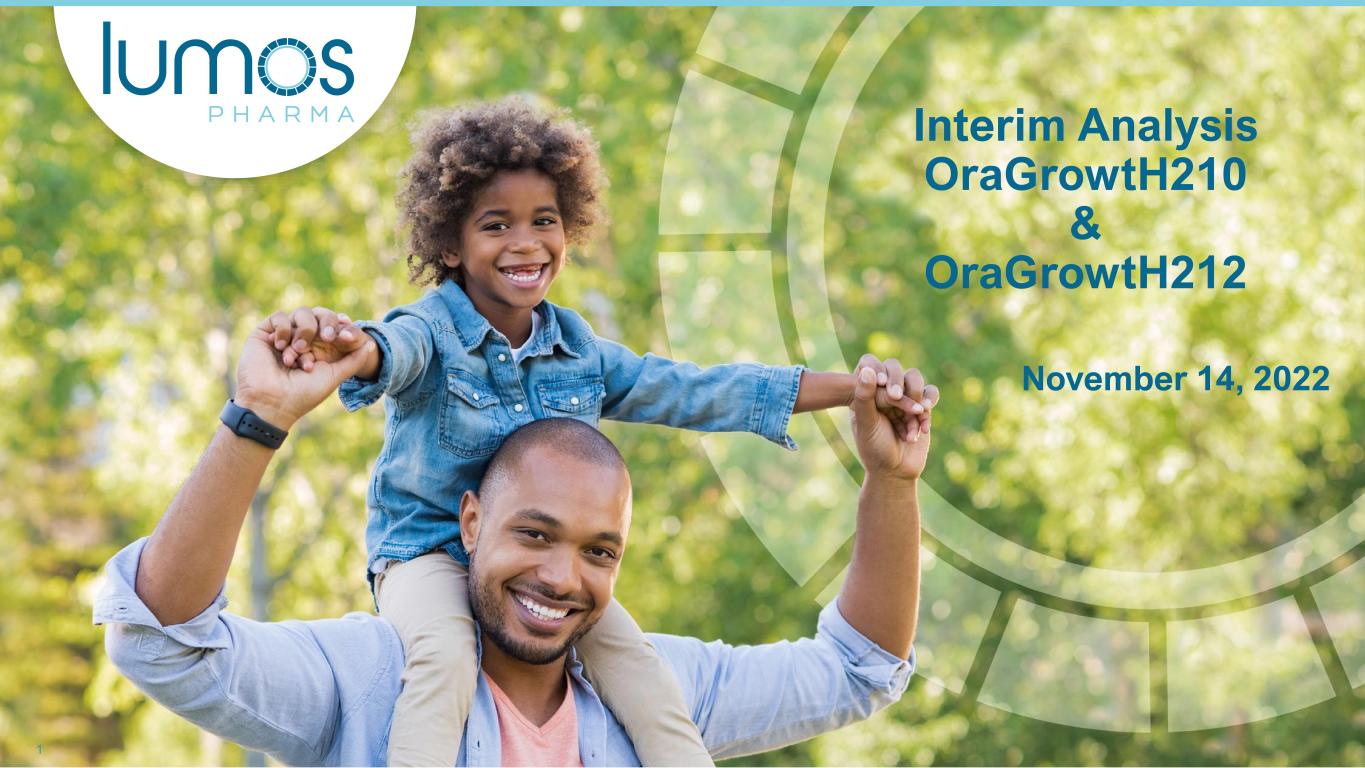
1 Interim Analysis OraGrowtH210 & OraGrowtH212 November 14, 2022
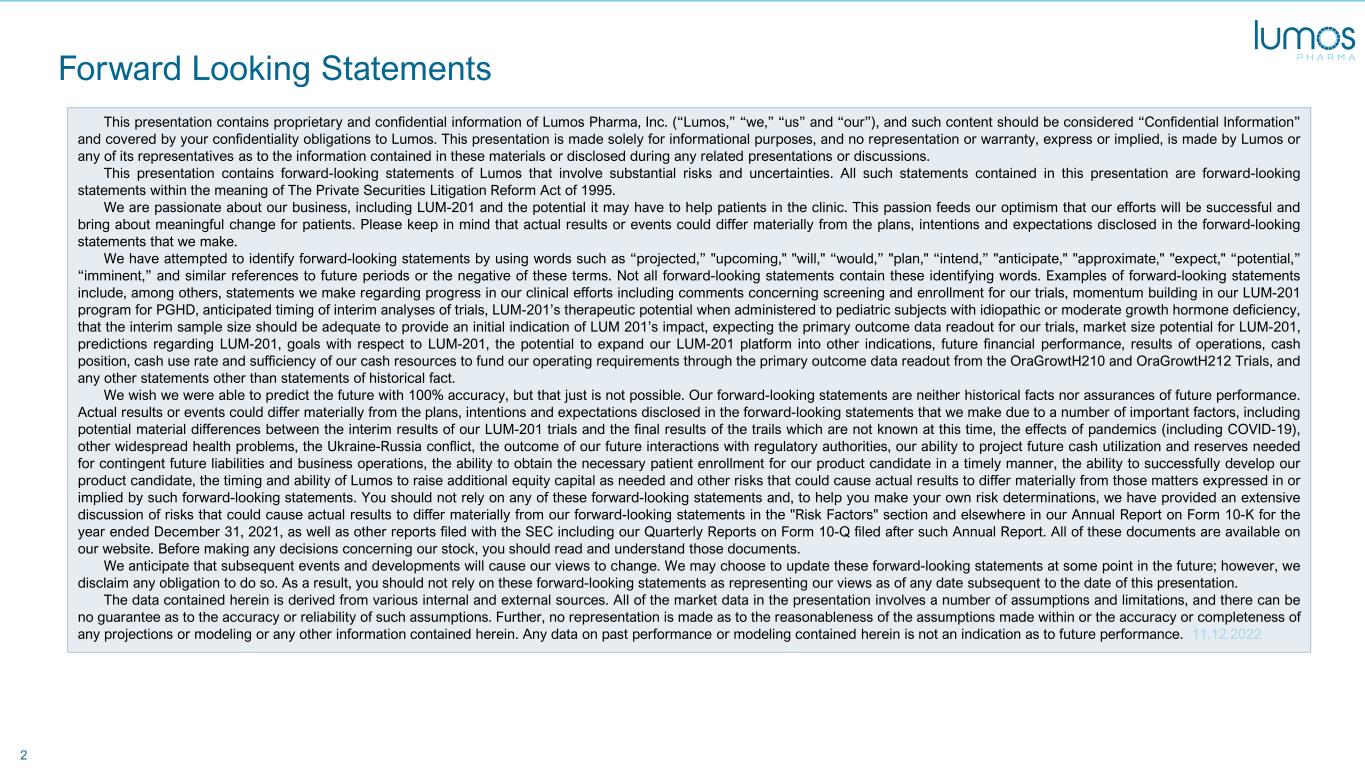
2 Forward Looking Statements This presentation contains proprietary and confidential information of Lumos Pharma, Inc. (“Lumos,” “we,” “us” and “our”), and such content should be considered “Confidential Information” and covered by your confidentiality obligations to Lumos. This presentation is made solely for informational purposes, and no representation or warranty, express or implied, is made by Lumos or any of its representatives as to the information contained in these materials or disclosed during any related presentations or discussions. This presentation contains forward-looking statements of Lumos that involve substantial risks and uncertainties. All such statements contained in this presentation are forward-looking statements within the meaning of The Private Securities Litigation Reform Act of 1995. We are passionate about our business, including LUM-201 and the potential it may have to help patients in the clinic. This passion feeds our optimism that our efforts will be successful and bring about meaningful change for patients. Please keep in mind that actual results or events could differ materially from the plans, intentions and expectations disclosed in the forward-looking statements that we make. We have attempted to identify forward-looking statements by using words such as “projected,” "upcoming," "will," “would,” "plan," “intend,” "anticipate," "approximate," "expect," “potential,” “imminent,” and similar references to future periods or the negative of these terms. Not all forward-looking statements contain these identifying words. Examples of forward-looking statements include, among others, statements we make regarding progress in our clinical efforts including comments concerning screening and enrollment for our trials, momentum building in our LUM-201 program for PGHD, anticipated timing of interim analyses of trials, LUM-201’s therapeutic potential when administered to pediatric subjects with idiopathic or moderate growth hormone deficiency, that the interim sample size should be adequate to provide an initial indication of LUM 201’s impact, expecting the primary outcome data readout for our trials, market size potential for LUM-201, predictions regarding LUM-201, goals with respect to LUM-201, the potential to expand our LUM-201 platform into other indications, future financial performance, results of operations, cash position, cash use rate and sufficiency of our cash resources to fund our operating requirements through the primary outcome data readout from the OraGrowtH210 and OraGrowtH212 Trials, and any other statements other than statements of historical fact. We wish we were able to predict the future with 100% accuracy, but that just is not possible. Our forward-looking statements are neither historical facts nor assurances of future performance. Actual results or events could differ materially from the plans, intentions and expectations disclosed in the forward-looking statements that we make due to a number of important factors, including potential material differences between the interim results of our LUM-201 trials and the final results of the trails which are not known at this time, the effects of pandemics (including COVID-19), other widespread health problems, the Ukraine-Russia conflict, the outcome of our future interactions with regulatory authorities, our ability to project future cash utilization and reserves needed for contingent future liabilities and business operations, the ability to obtain the necessary patient enrollment for our product candidate in a timely manner, the ability to successfully develop our product candidate, the timing and ability of Lumos to raise additional equity capital as needed and other risks that could cause actual results to differ materially from those matters expressed in or implied by such forward-looking statements. You should not rely on any of these forward-looking statements and, to help you make your own risk determinations, we have provided an extensive discussion of risks that could cause actual results to differ materially from our forward-looking statements in the "Risk Factors" section and elsewhere in our Annual Report on Form 10-K for the year ended December 31, 2021, as well as other reports filed with the SEC including our Quarterly Reports on Form 10-Q filed after such Annual Report. All of these documents are available on our website. Before making any decisions concerning our stock, you should read and understand those documents. We anticipate that subsequent events and developments will cause our views to change. We may choose to update these forward-looking statements at some point in the future; however, we disclaim any obligation to do so. As a result, you should not rely on these forward-looking statements as representing our views as of any date subsequent to the date of this presentation. The data contained herein is derived from various internal and external sources. All of the market data in the presentation involves a number of assumptions and limitations, and there can be no guarantee as to the accuracy or reliability of such assumptions. Further, no representation is made as to the reasonableness of the assumptions made within or the accuracy or completeness of any projections or modeling or any other information contained herein. Any data on past performance or modeling contained herein is not an indication as to future performance. 11.12.2022
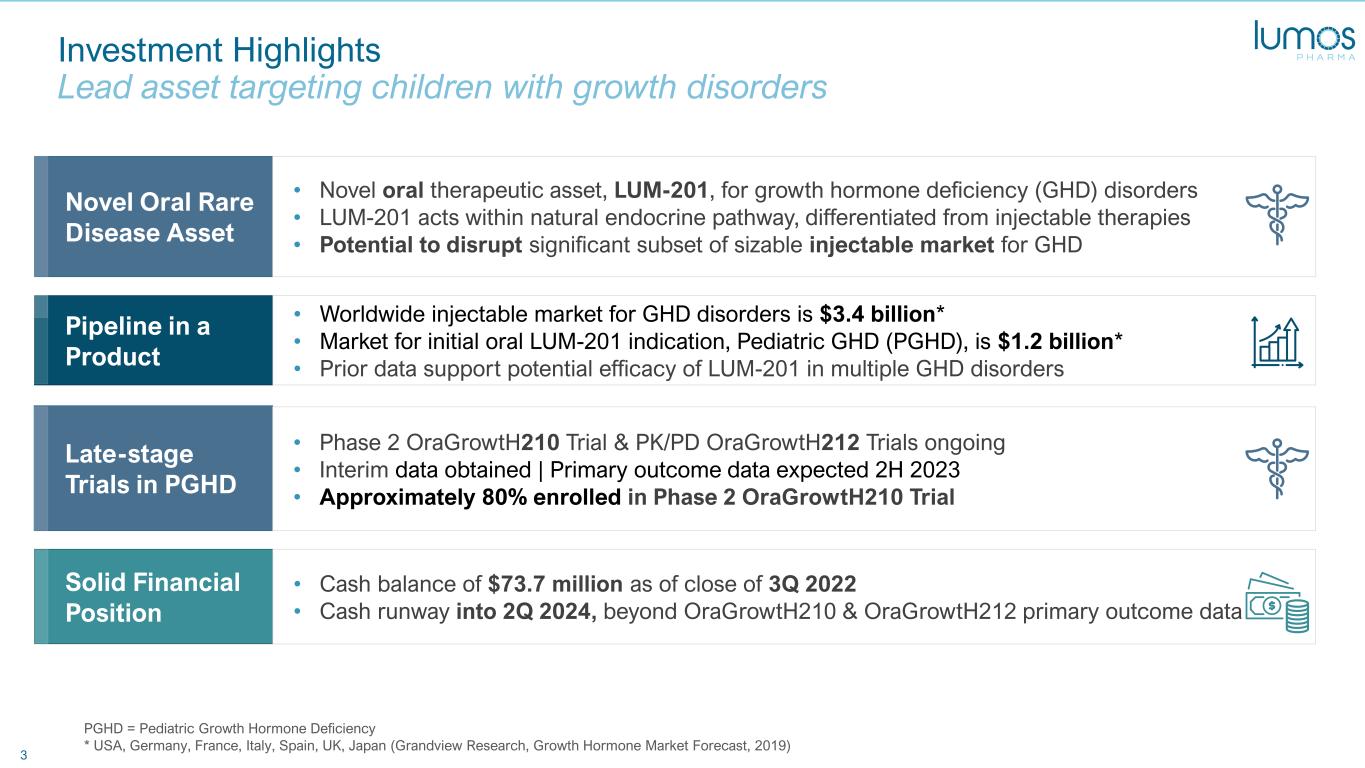
3 Investment Highlights Lead asset targeting children with growth disorders PGHD = Pediatric Growth Hormone Deficiency * USA, Germany, France, Italy, Spain, UK, Japan (Grandview Research, Growth Hormone Market Forecast, 2019) Novel Oral Rare Disease Asset Pipeline in a Product Solid Financial Position • Novel oral therapeutic asset, LUM-201, for growth hormone deficiency (GHD) disorders • LUM-201 acts within natural endocrine pathway, differentiated from injectable therapies • Potential to disrupt significant subset of sizable injectable market for GHD • Worldwide injectable market for GHD disorders is $3.4 billion* • Market for initial oral LUM-201 indication, Pediatric GHD (PGHD), is $1.2 billion* • Prior data support potential efficacy of LUM-201 in multiple GHD disorders • Cash balance of $73.7 million as of close of 3Q 2022 • Cash runway into 2Q 2024, beyond OraGrowtH210 & OraGrowtH212 primary outcome data Late-stage Trials in PGHD • Phase 2 OraGrowtH210 Trial & PK/PD OraGrowtH212 Trials ongoing • Interim data obtained | Primary outcome data expected 2H 2023 • Approximately 80% enrolled in Phase 2 OraGrowtH210 Trial
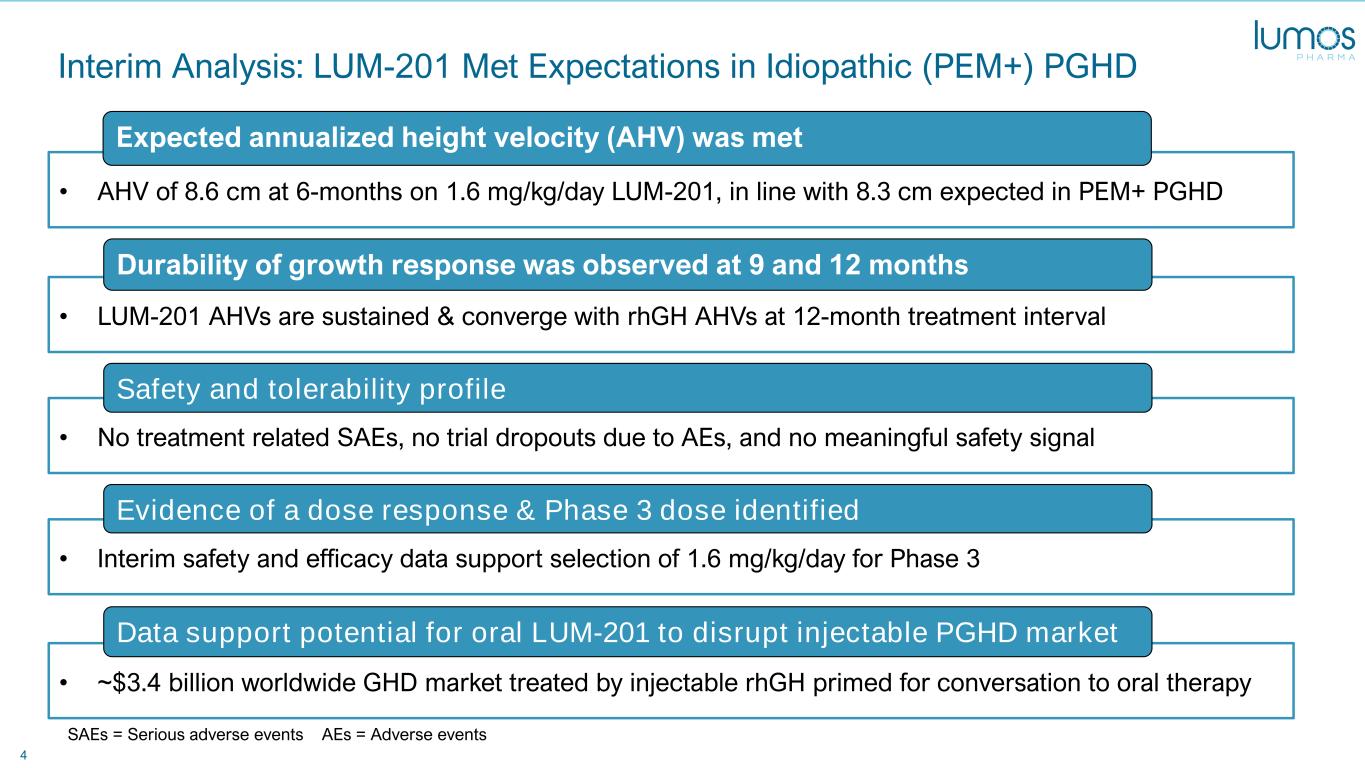
4 Interim Analysis: LUM-201 Met Expectations in Idiopathic (PEM+) PGHD SAEs = Serious adverse events AEs = Adverse events • AHV of 8.6 cm at 6-months on 1.6 mg/kg/day LUM-201, in line with 8.3 cm expected in PEM+ PGHD • LUM-201 AHVs are sustained & converge with rhGH AHVs at 12-month treatment interval • No treatment related SAEs, no trial dropouts due to AEs, and no meaningful safety signal • Interim safety and efficacy data support selection of 1.6 mg/kg/day for Phase 3 • ~$3.4 billion worldwide GHD market treated by injectable rhGH primed for conversation to oral therapy Expected annualized height velocity (AHV) was met Durability of growth response was observed at 9 and 12 months Safety and tolerability profile Evidence of a dose response & Phase 3 dose identified Data support potential for oral LUM-201 to disrupt injectable PGHD market

OraGrowtH210 Trial Phase 2 Trial Evaluating Oral LUM-201 in Moderate PGHD
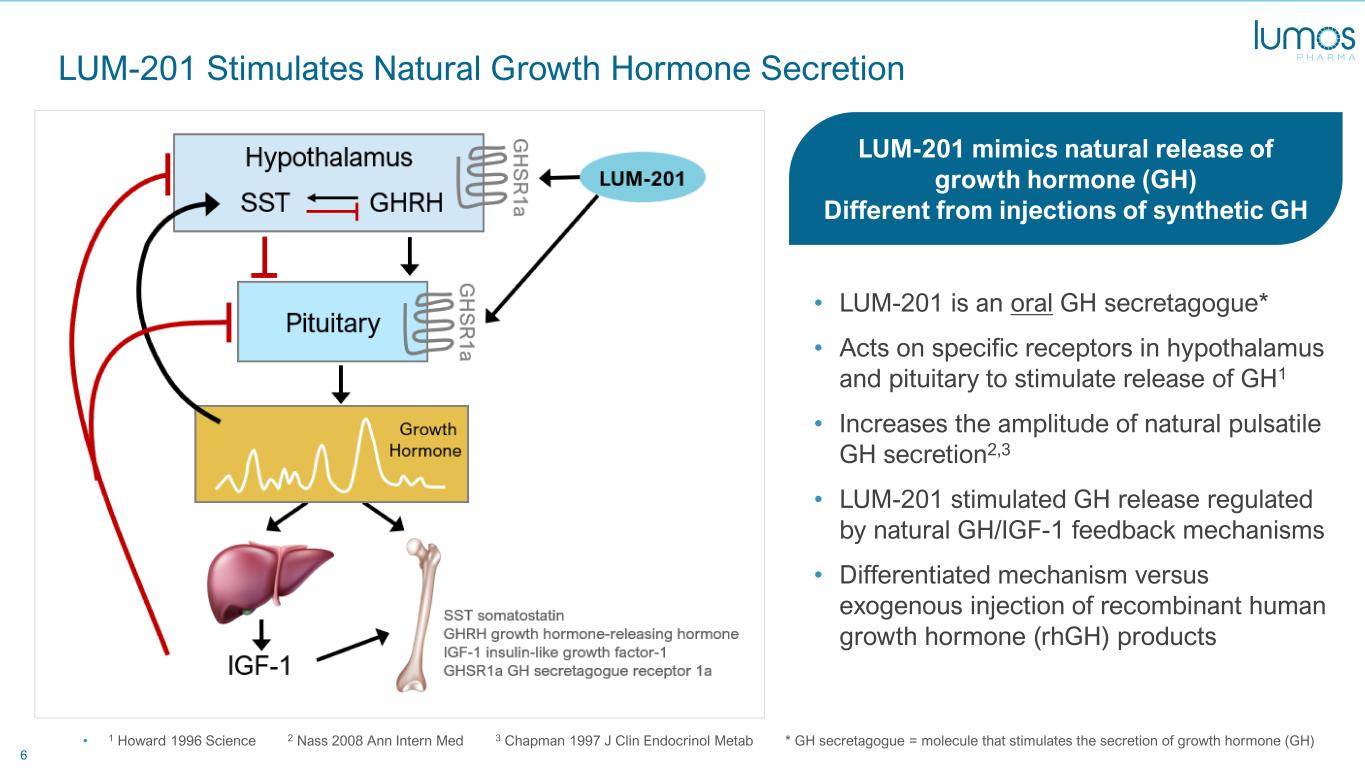
6 LUM-201 Stimulates Natural Growth Hormone Secretion • LUM-201 is an oral GH secretagogue* • Acts on specific receptors in hypothalamus and pituitary to stimulate release of GH1 • Increases the amplitude of natural pulsatile GH secretion2,3 • LUM-201 stimulated GH release regulated by natural GH/IGF-1 feedback mechanisms • Differentiated mechanism versus exogenous injection of recombinant human growth hormone (rhGH) products LUM-201 mimics natural release of growth hormone (GH) Different from injections of synthetic GH • 1 Howard 1996 Science 2 Nass 2008 Ann Intern Med 3 Chapman 1997 J Clin Endocrinol Metab * GH secretagogue = molecule that stimulates the secretion of growth hormone (GH)
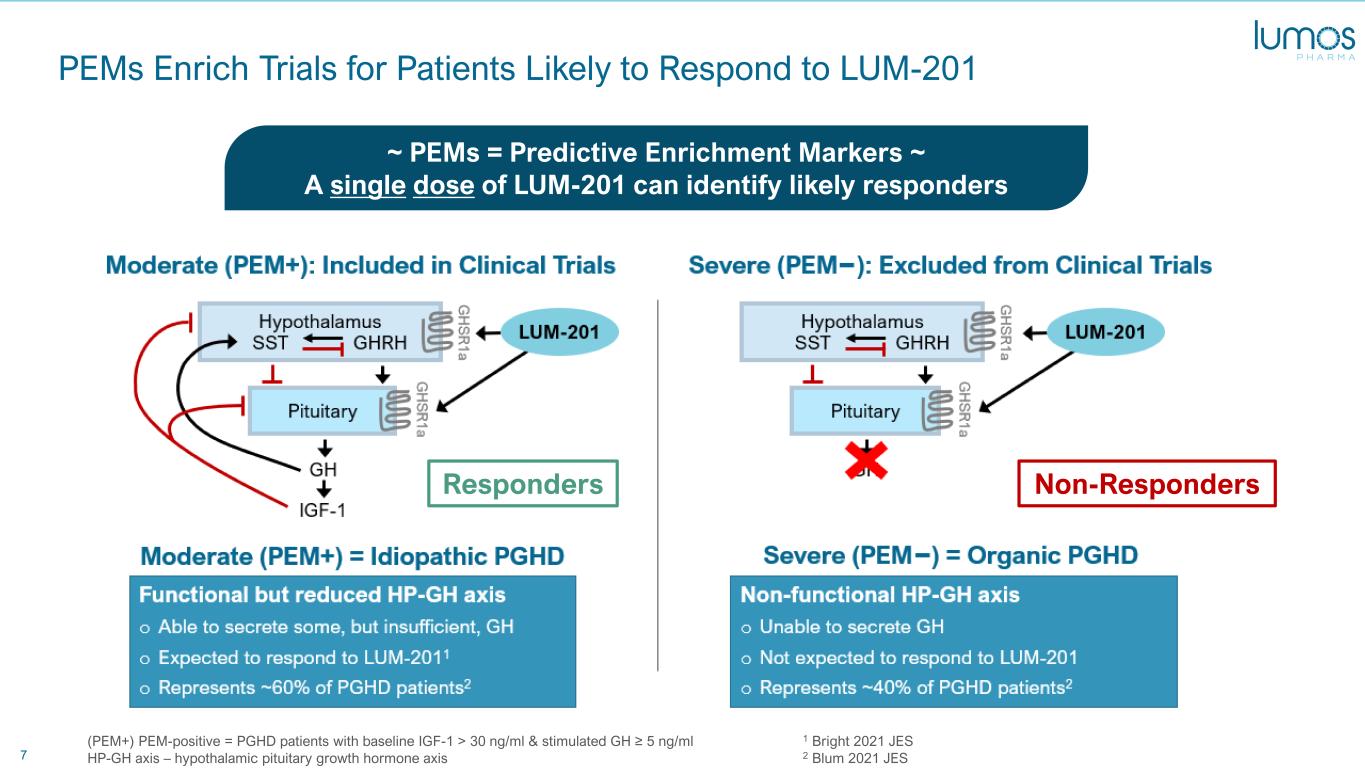
7 PEMs Enrich Trials for Patients Likely to Respond to LUM-201 (PEM+) PEM-positive = PGHD patients with baseline IGF-1 > 30 ng/ml & stimulated GH ≥ 5 ng/ml 1 Bright 2021 JES HP-GH axis – hypothalamic pituitary growth hormone axis 2 Blum 2021 JES Responders Non-Responders ~ PEMs = Predictive Enrichment Markers ~ A single dose of LUM-201 can identify likely responders
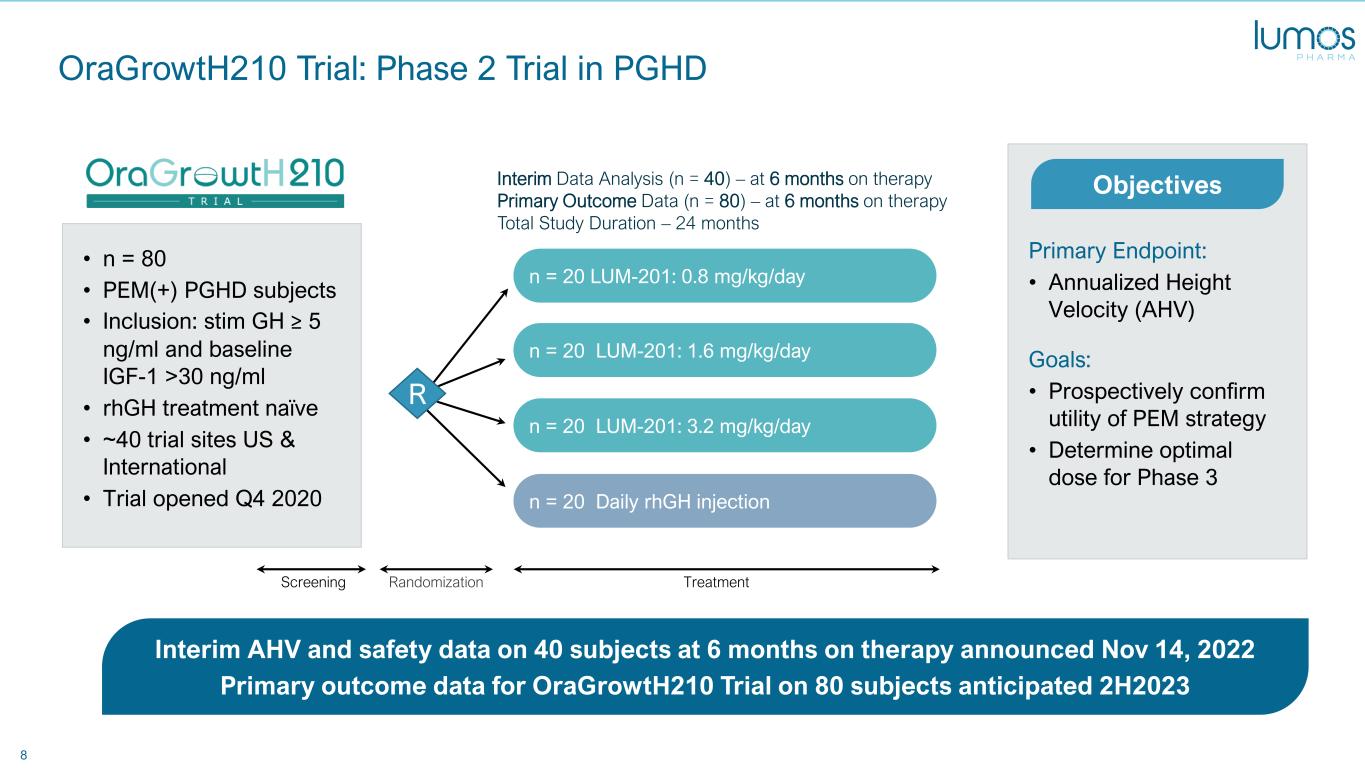
8 OraGrowtH210 Trial: Phase 2 Trial in PGHD n = 20 Daily rhGH injection n = 20 LUM-201: 3.2 mg/kg/day n = 20 LUM-201: 1.6 mg/kg/day n = 20 LUM-201: 0.8 mg/kg/day • n = 80 • PEM(+) PGHD subjects • Inclusion: stim GH ≥ 5 ng/ml and baseline IGF-1 >30 ng/ml • rhGH treatment naïve • ~40 trial sites US & International • Trial opened Q4 2020 Primary Endpoint: • Annualized Height Velocity (AHV) Goals: • Prospectively confirm utility of PEM strategy • Determine optimal dose for Phase 3 Interim AHV and safety data on 40 subjects at 6 months on therapy announced Nov 14, 2022 Primary outcome data for OraGrowtH210 Trial on 80 subjects anticipated 2H2023 Interim Data Analysis (n = 40) – at 6 months on therapy Primary Outcome Data (n = 80) – at 6 months on therapy Total Study Duration – 24 months Objectives TreatmentRandomizationScreening R
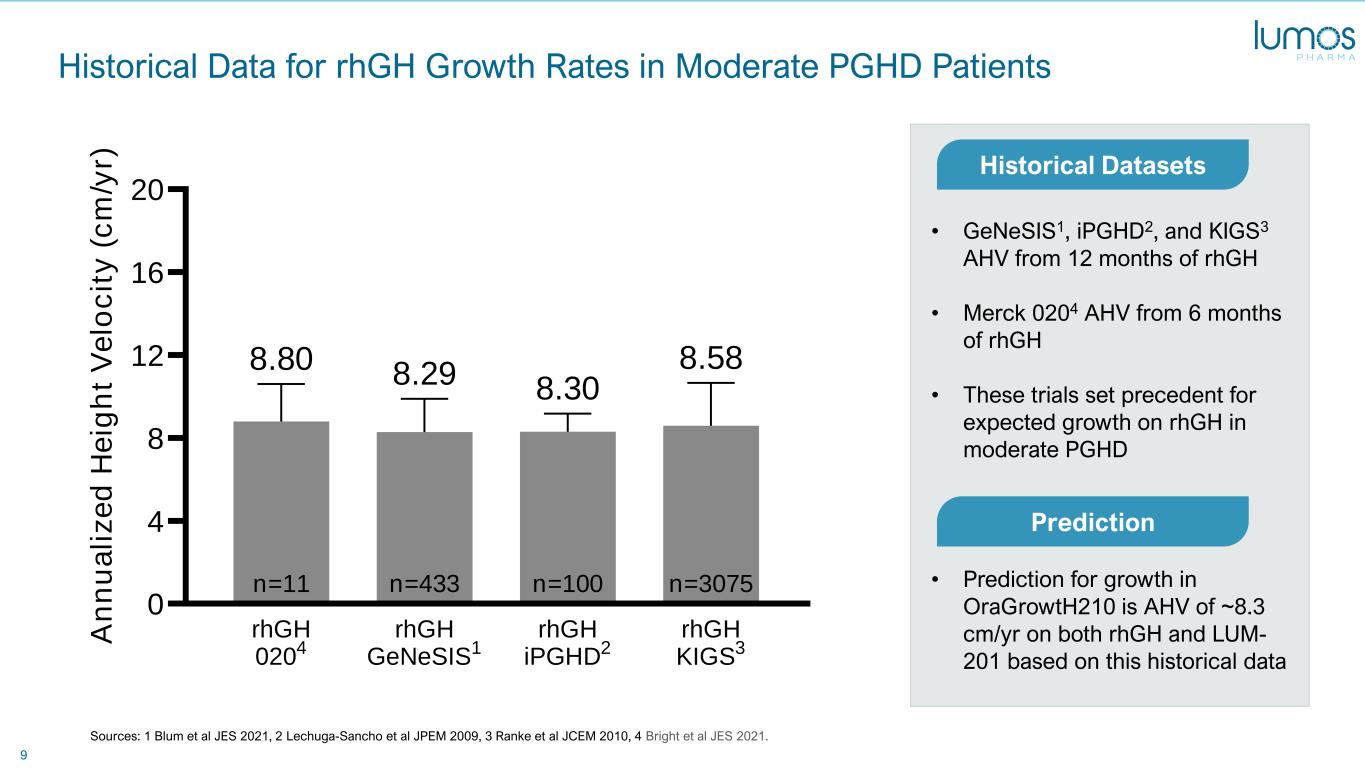
9 Historical Data for rhGH Growth Rates in Moderate PGHD Patients rhGH 0204 rhGH GeNeSIS1 rhGH iPGHD2 rhGH KIGS3 0 4 8 12 16 20 n=3075 8.58 n=100 8.30 n=433 8.29 n=11 8.80 A n n u a li z e d H e ig h t V e lo c it y ( c m /y r) • GeNeSIS1, iPGHD2, and KIGS3 AHV from 12 months of rhGH • Merck 0204 AHV from 6 months of rhGH • These trials set precedent for expected growth on rhGH in moderate PGHD • Prediction for growth in OraGrowtH210 is AHV of ~8.3 cm/yr on both rhGH and LUM- 201 based on this historical data Historical Datasets Prediction Sources: 1 Blum et al JES 2021, 2 Lechuga-Sancho et al JPEM 2009, 3 Ranke et al JCEM 2010, 4 Bright et al JES 2021.
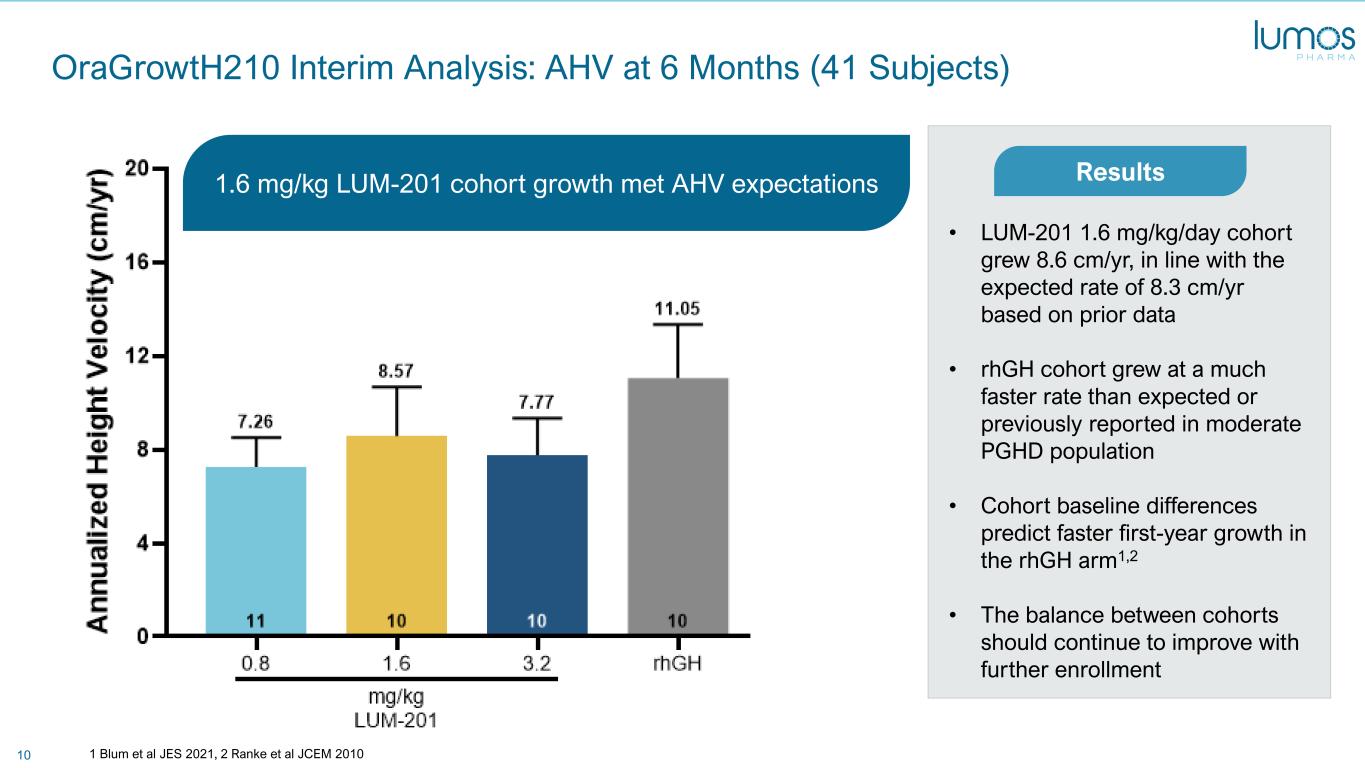
10 OraGrowtH210 Interim Analysis: AHV at 6 Months (41 Subjects) • LUM-201 1.6 mg/kg/day cohort grew 8.6 cm/yr, in line with the expected rate of 8.3 cm/yr based on prior data • rhGH cohort grew at a much faster rate than expected or previously reported in moderate PGHD population • Cohort baseline differences predict faster first-year growth in the rhGH arm1,2 • The balance between cohorts should continue to improve with further enrollment Results1.6 mg/kg LUM-201 cohort growth met AHV expectations 1 Blum et al JES 2021, 2 Ranke et al JCEM 2010
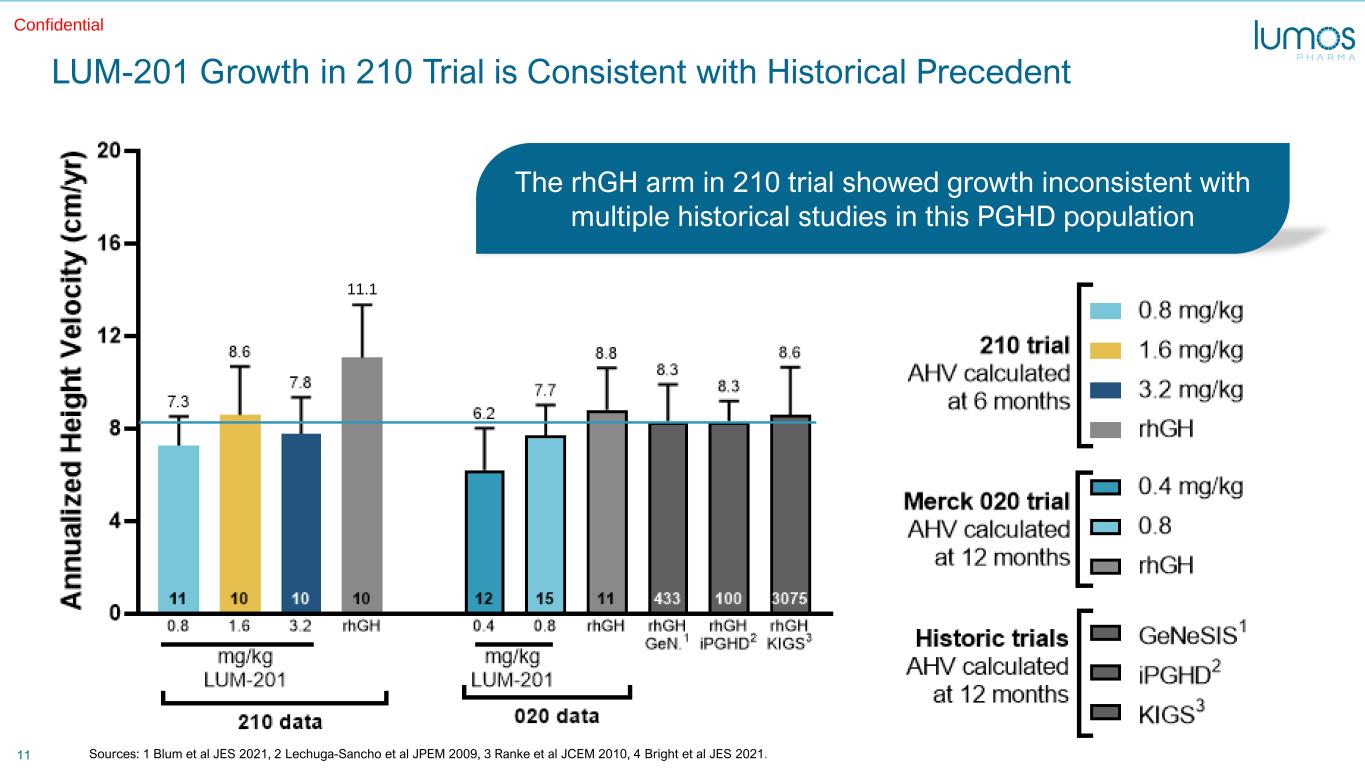
11 LUM-201 Growth in 210 Trial is Consistent with Historical Precedent The rhGH arm in 210 trial showed growth inconsistent with multiple historical studies in this PGHD population Sources: 1 Blum et al JES 2021, 2 Lechuga-Sancho et al JPEM 2009, 3 Ranke et al JCEM 2010, 4 Bright et al JES 2021. Confidential 11.1
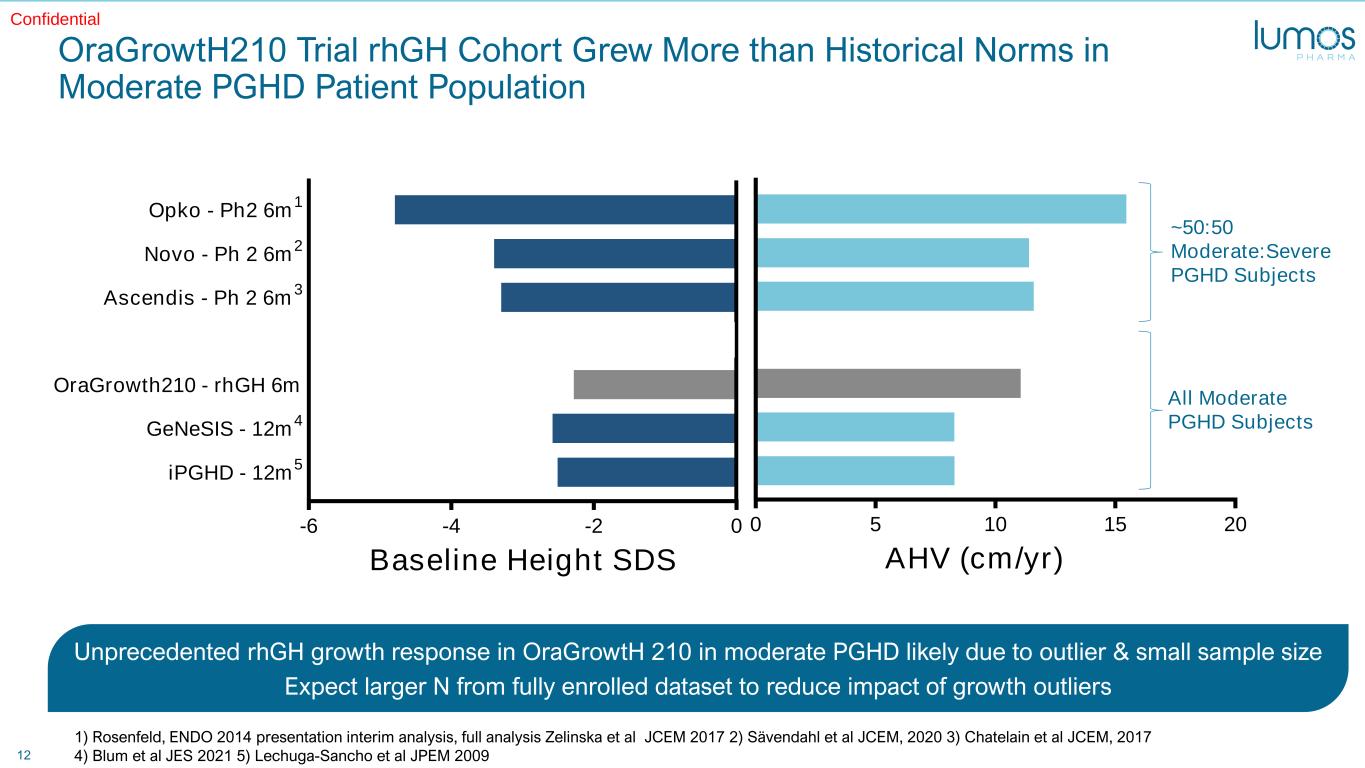
12 OraGrowtH210 Trial rhGH Cohort Grew More than Historical Norms in Moderate PGHD Patient Population Unprecedented rhGH growth response in OraGrowtH 210 in moderate PGHD likely due to outlier & small sample size Expect larger N from fully enrolled dataset to reduce impact of growth outliers 1) Rosenfeld, ENDO 2014 presentation interim analysis, full analysis Zelinska et al JCEM 2017 2) Sävendahl et al JCEM, 2020 3) Chatelain et al JCEM, 2017 4) Blum et al JES 2021 5) Lechuga-Sancho et al JPEM 2009 Confidential -6 -4 -2 0 iPGHD - 12m 5 GeNeSIS - 12m 4 OraGrowth210 - rhGH 6m OraGrowth210 - 1.6mg/kg 6m Ascendis - Ph 2 6m 3 Novo - Ph 2 6m 2 Opko - Ph2 6m 1 Baseline Height SDS ~50:50 Moderate:Severe PGHD Subjects All Moderate PGHD Subjects 0 5 10 15 20 1 2 3 4 5 6 7 AHV (cm/yr)
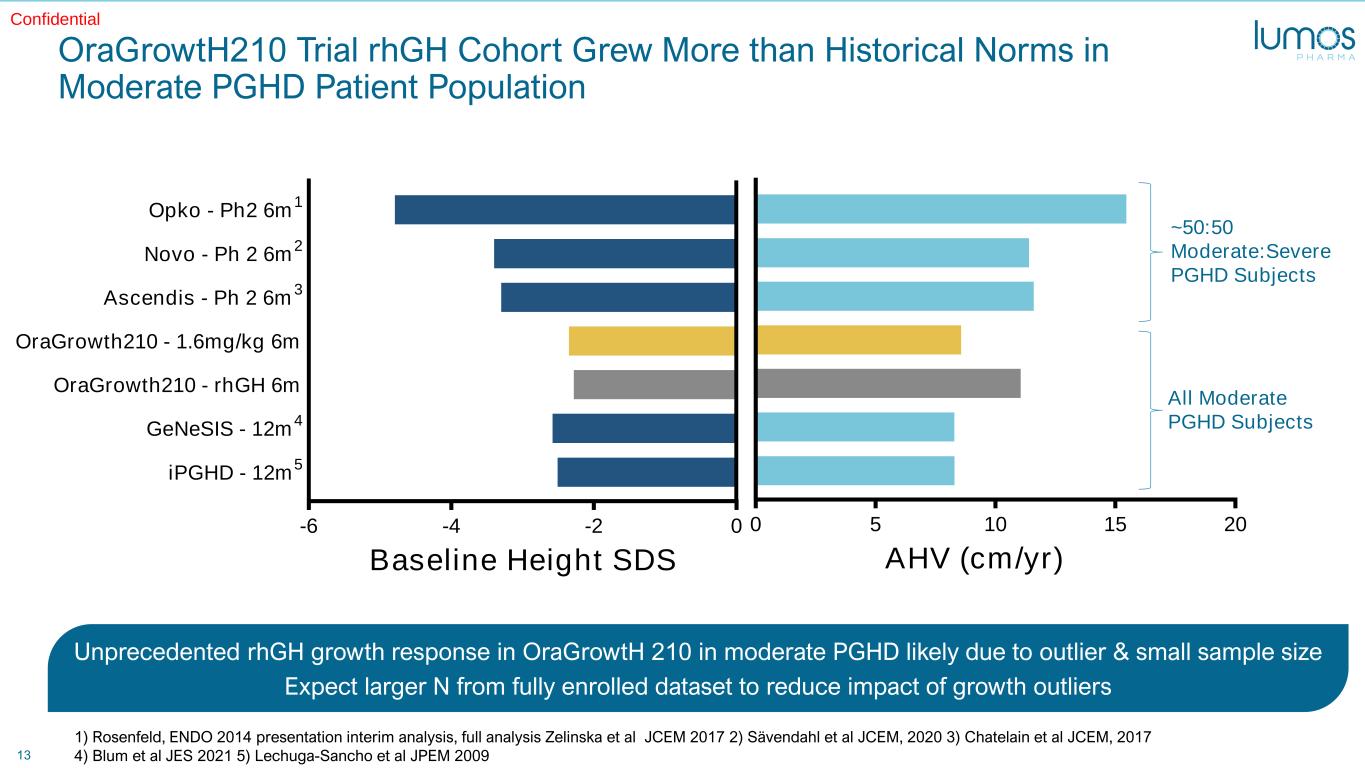
13 OraGrowtH210 Trial rhGH Cohort Grew More than Historical Norms in Moderate PGHD Patient Population Unprecedented rhGH growth response in OraGrowtH 210 in moderate PGHD likely due to outlier & small sample size Expect larger N from fully enrolled dataset to reduce impact of growth outliers 1) Rosenfeld, ENDO 2014 presentation interim analysis, full analysis Zelinska et al JCEM 2017 2) Sävendahl et al JCEM, 2020 3) Chatelain et al JCEM, 2017 4) Blum et al JES 2021 5) Lechuga-Sancho et al JPEM 2009 ~50:50 Moderate:Severe PGHD Subjects All Moderate PGHD Subjects Confidential 0 5 10 15 20 1 2 3 4 5 6 7 AHV (cm/yr) -6 -4 -2 0 iPGHD - 12m 5 GeNeSIS - 12m 4 OraGrowth210 - rhGH 6m OraGrowth210 - 1.6mg/kg 6m Ascendis - Ph 2 6m 3 Novo - Ph 2 6m 2 Opko - Ph2 6m 1 Baseline Height SDS
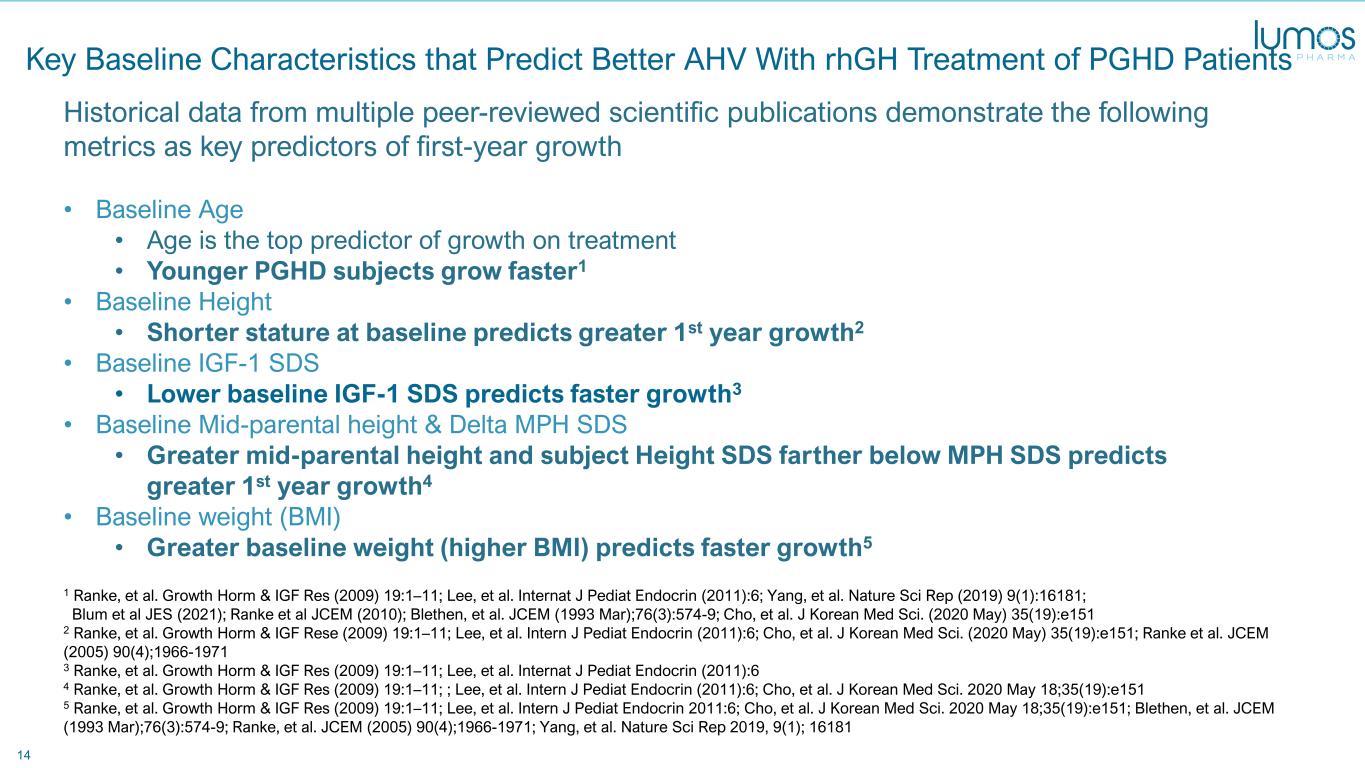
14 Key Baseline Characteristics that Predict Better AHV With rhGH Treatment of PGHD Patients Historical data from multiple peer-reviewed scientific publications demonstrate the following metrics as key predictors of first-year growth • Baseline Age • Age is the top predictor of growth on treatment • Younger PGHD subjects grow faster1 • Baseline Height • Shorter stature at baseline predicts greater 1st year growth2 • Baseline IGF-1 SDS • Lower baseline IGF-1 SDS predicts faster growth3 • Baseline Mid-parental height & Delta MPH SDS • Greater mid-parental height and subject Height SDS farther below MPH SDS predicts greater 1st year growth4 • Baseline weight (BMI) • Greater baseline weight (higher BMI) predicts faster growth5 1 Ranke, et al. Growth Horm & IGF Res (2009) 19:1–11; Lee, et al. Internat J Pediat Endocrin (2011):6; Yang, et al. Nature Sci Rep (2019) 9(1):16181; Blum et al JES (2021); Ranke et al JCEM (2010); Blethen, et al. JCEM (1993 Mar);76(3):574-9; Cho, et al. J Korean Med Sci. (2020 May) 35(19):e151 2 Ranke, et al. Growth Horm & IGF Rese (2009) 19:1–11; Lee, et al. Intern J Pediat Endocrin (2011):6; Cho, et al. J Korean Med Sci. (2020 May) 35(19):e151; Ranke et al. JCEM (2005) 90(4);1966-1971 3 Ranke, et al. Growth Horm & IGF Res (2009) 19:1–11; Lee, et al. Internat J Pediat Endocrin (2011):6 4 Ranke, et al. Growth Horm & IGF Res (2009) 19:1–11; ; Lee, et al. Intern J Pediat Endocrin (2011):6; Cho, et al. J Korean Med Sci. 2020 May 18;35(19):e151 5 Ranke, et al. Growth Horm & IGF Res (2009) 19:1–11; Lee, et al. Intern J Pediat Endocrin 2011:6; Cho, et al. J Korean Med Sci. 2020 May 18;35(19):e151; Blethen, et al. JCEM (1993 Mar);76(3):574-9; Ranke, et al. JCEM (2005) 90(4);1966-1971; Yang, et al. Nature Sci Rep 2019, 9(1); 16181
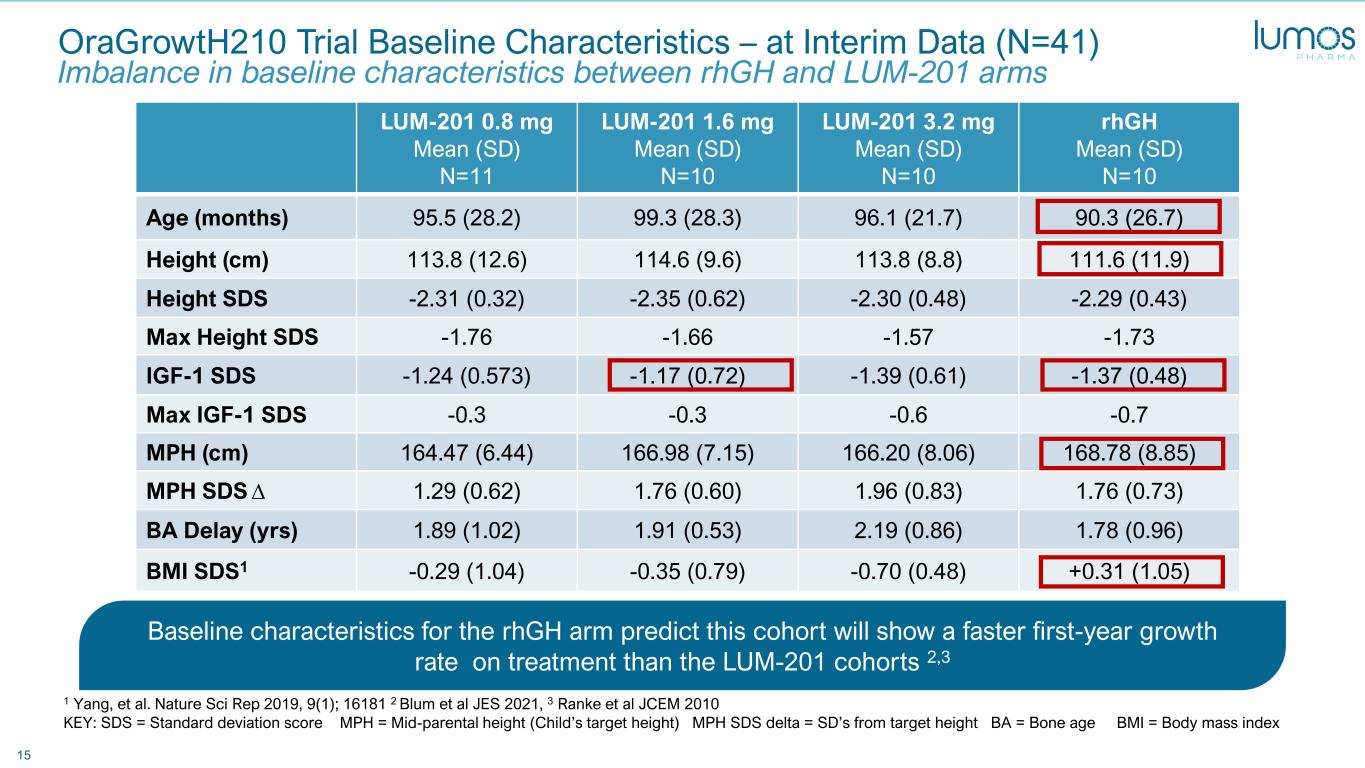
15 LUM-201 0.8 mg Mean (SD) N=11 LUM-201 1.6 mg Mean (SD) N=10 LUM-201 3.2 mg Mean (SD) N=10 rhGH Mean (SD) N=10 Age (months) 95.5 (28.2) 99.3 (28.3) 96.1 (21.7) 90.3 (26.7) Height (cm) 113.8 (12.6) 114.6 (9.6) 113.8 (8.8) 111.6 (11.9) Height SDS -2.31 (0.32) -2.35 (0.62) -2.30 (0.48) -2.29 (0.43) Max Height SDS -1.76 -1.66 -1.57 -1.73 IGF-1 SDS -1.24 (0.573) -1.17 (0.72) -1.39 (0.61) -1.37 (0.48) Max IGF-1 SDS -0.3 -0.3 -0.6 -0.7 MPH (cm) 164.47 (6.44) 166.98 (7.15) 166.20 (8.06) 168.78 (8.85) MPH SDS∆ 1.29 (0.62) 1.76 (0.60) 1.96 (0.83) 1.76 (0.73) BA Delay (yrs) 1.89 (1.02) 1.91 (0.53) 2.19 (0.86) 1.78 (0.96) BMI SDS1 -0.29 (1.04) -0.35 (0.79) -0.70 (0.48) +0.31 (1.05) 1 Yang, et al. Nature Sci Rep 2019, 9(1); 16181 2 Blum et al JES 2021, 3 Ranke et al JCEM 2010 KEY: SDS = Standard deviation score MPH = Mid-parental height (Child’s target height) MPH SDS delta = SD’s from target height BA = Bone age BMI = Body mass index Baseline characteristics for the rhGH arm predict this cohort will show a faster first-year growth rate on treatment than the LUM-201 cohorts 2,3 OraGrowtH210 Trial Baseline Characteristics – at Interim Data (N=41) Imbalance in baseline characteristics between rhGH and LUM-201 arms
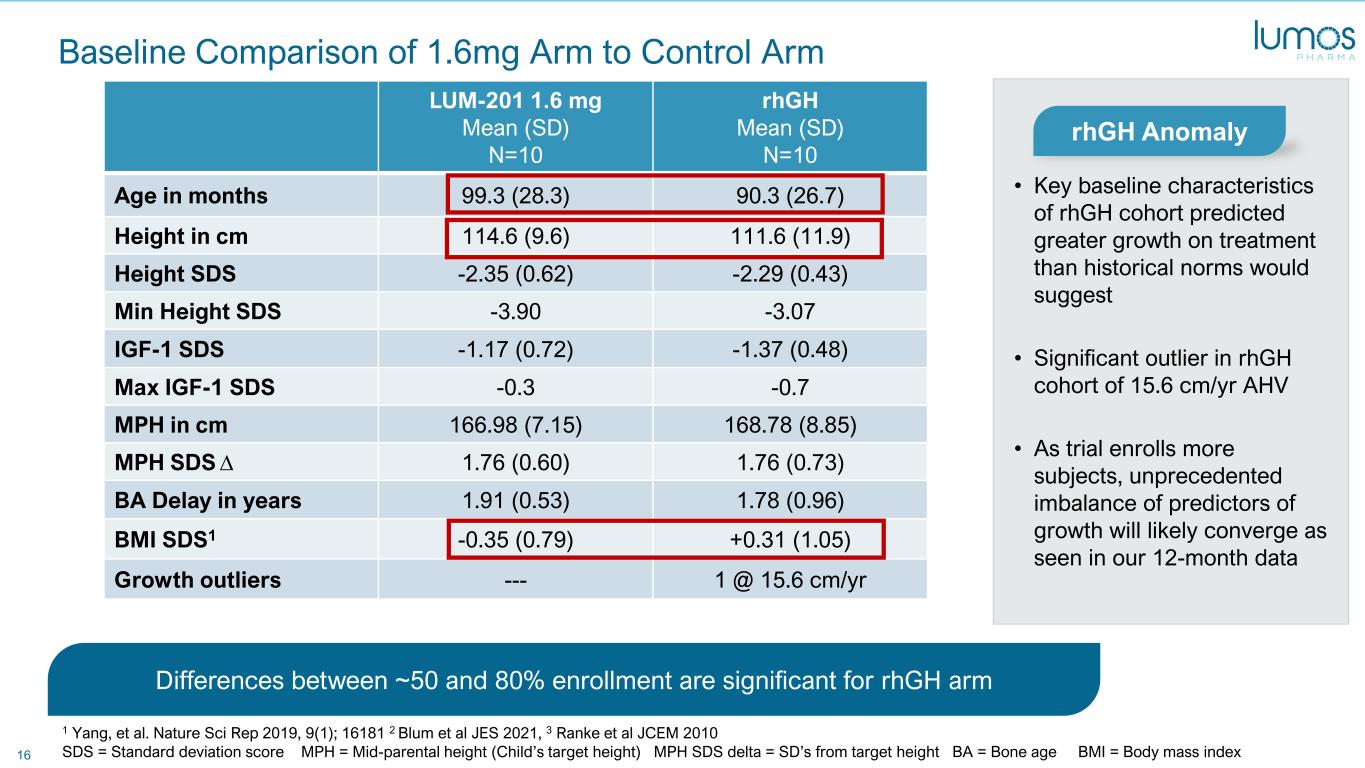
16 Baseline Comparison of 1.6mg Arm to Control Arm LUM-201 1.6 mg Mean (SD) N=10 rhGH Mean (SD) N=10 Age in months 99.3 (28.3) 90.3 (26.7) Height in cm 114.6 (9.6) 111.6 (11.9) Height SDS -2.35 (0.62) -2.29 (0.43) Min Height SDS -3.90 -3.07 IGF-1 SDS -1.17 (0.72) -1.37 (0.48) Max IGF-1 SDS -0.3 -0.7 MPH in cm 166.98 (7.15) 168.78 (8.85) MPH SDS∆ 1.76 (0.60) 1.76 (0.73) BA Delay in years 1.91 (0.53) 1.78 (0.96) BMI SDS1 -0.35 (0.79) +0.31 (1.05) Growth outliers --- 1 @ 15.6 cm/yr 1 Yang, et al. Nature Sci Rep 2019, 9(1); 16181 2 Blum et al JES 2021, 3 Ranke et al JCEM 2010 SDS = Standard deviation score MPH = Mid-parental height (Child’s target height) MPH SDS delta = SD’s from target height BA = Bone age BMI = Body mass index • Key baseline characteristics of rhGH cohort predicted greater growth on treatment than historical norms would suggest • Significant outlier in rhGH cohort of 15.6 cm/yr AHV • As trial enrolls more subjects, unprecedented imbalance of predictors of growth will likely converge as seen in our 12-month data rhGH Anomaly Differences between ~50 and 80% enrollment are significant for rhGH arm
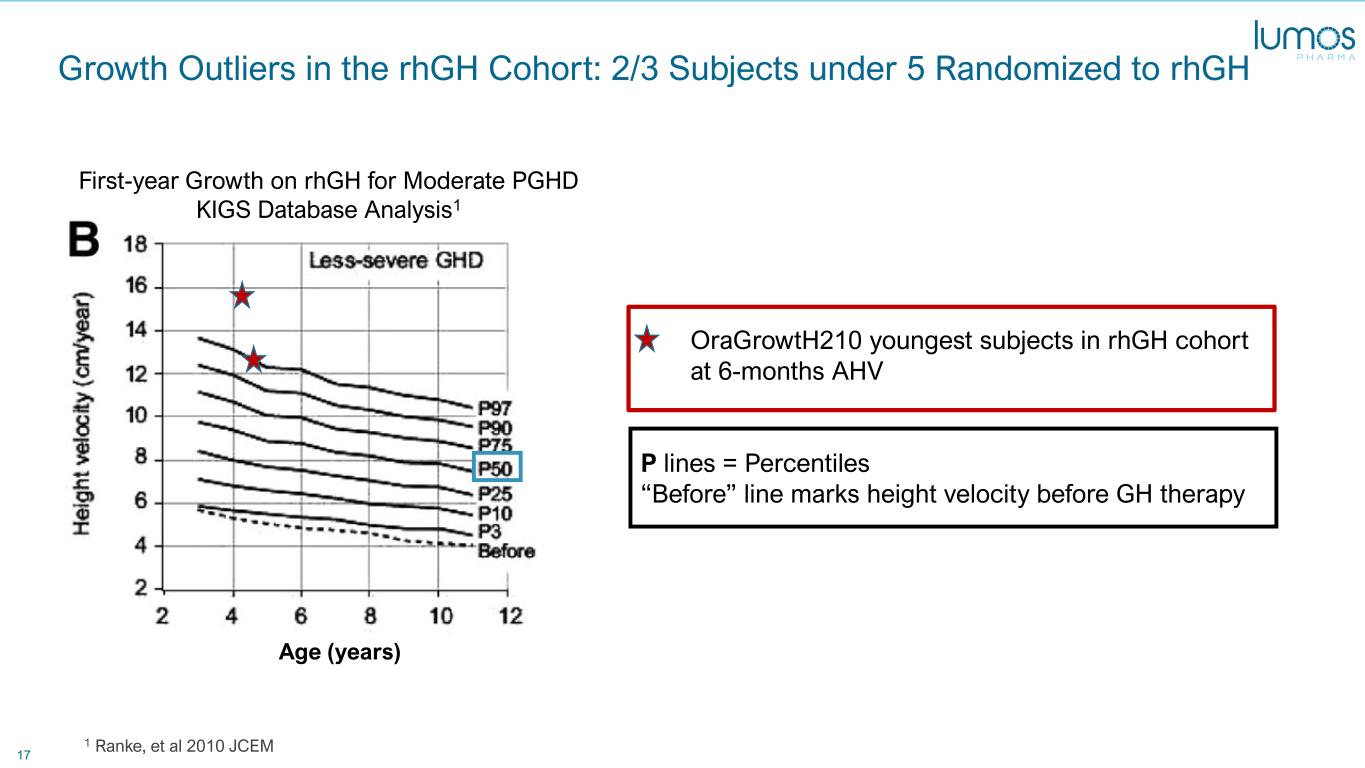
17 Age (years) Growth Outliers in the rhGH Cohort: 2/3 Subjects under 5 Randomized to rhGH 1 Ranke, et al 2010 JCEM OraGrowtH210 youngest subjects in rhGH cohort at 6-months AHV P lines = Percentiles “Before” line marks height velocity before GH therapy First-year Growth on rhGH for Moderate PGHD KIGS Database Analysis1
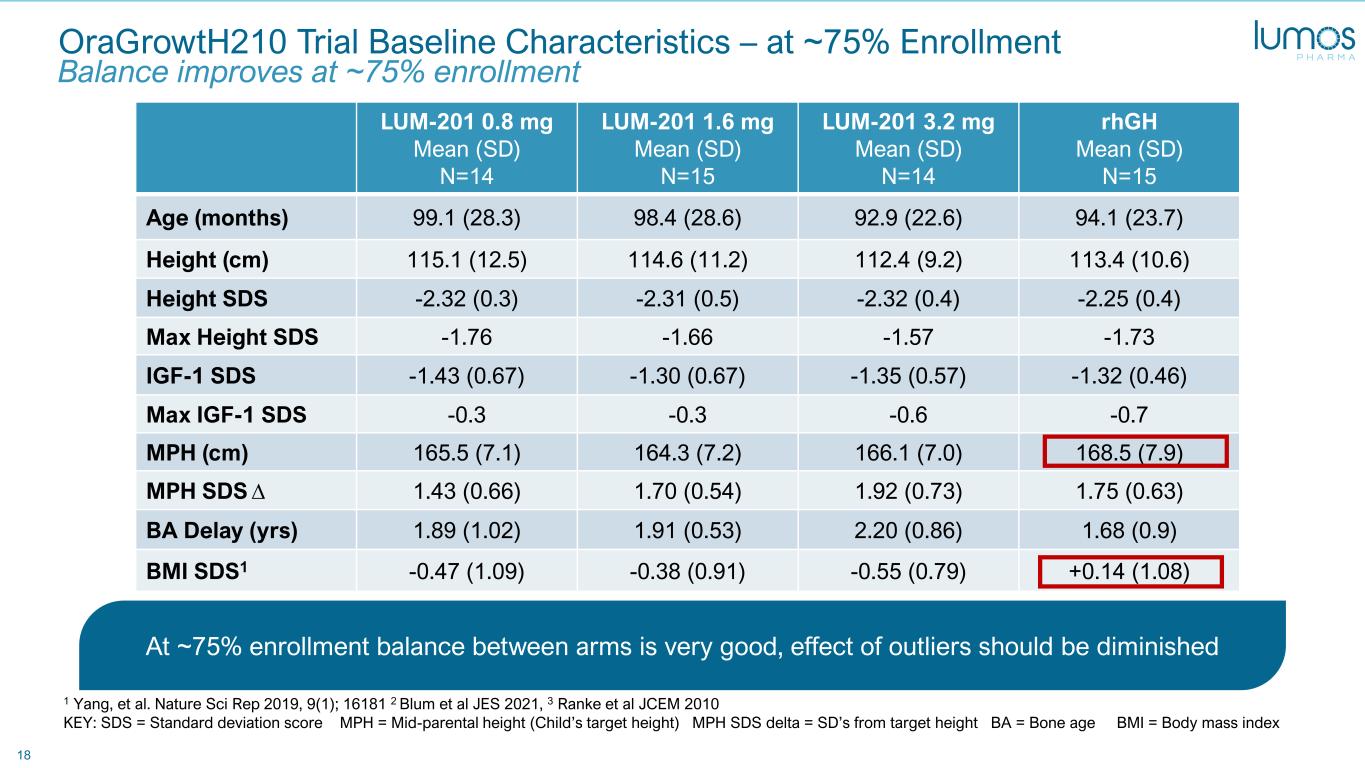
18 LUM-201 0.8 mg Mean (SD) N=14 LUM-201 1.6 mg Mean (SD) N=15 LUM-201 3.2 mg Mean (SD) N=14 rhGH Mean (SD) N=15 Age (months) 99.1 (28.3) 98.4 (28.6) 92.9 (22.6) 94.1 (23.7) Height (cm) 115.1 (12.5) 114.6 (11.2) 112.4 (9.2) 113.4 (10.6) Height SDS -2.32 (0.3) -2.31 (0.5) -2.32 (0.4) -2.25 (0.4) Max Height SDS -1.76 -1.66 -1.57 -1.73 IGF-1 SDS -1.43 (0.67) -1.30 (0.67) -1.35 (0.57) -1.32 (0.46) Max IGF-1 SDS -0.3 -0.3 -0.6 -0.7 MPH (cm) 165.5 (7.1) 164.3 (7.2) 166.1 (7.0) 168.5 (7.9) MPH SDS∆ 1.43 (0.66) 1.70 (0.54) 1.92 (0.73) 1.75 (0.63) BA Delay (yrs) 1.89 (1.02) 1.91 (0.53) 2.20 (0.86) 1.68 (0.9) BMI SDS1 -0.47 (1.09) -0.38 (0.91) -0.55 (0.79) +0.14 (1.08) 1 Yang, et al. Nature Sci Rep 2019, 9(1); 16181 2 Blum et al JES 2021, 3 Ranke et al JCEM 2010 KEY: SDS = Standard deviation score MPH = Mid-parental height (Child’s target height) MPH SDS delta = SD’s from target height BA = Bone age BMI = Body mass index At ~75% enrollment balance between arms is very good, effect of outliers should be diminished OraGrowtH210 Trial Baseline Characteristics – at ~75% Enrollment Balance improves at ~75% enrollment
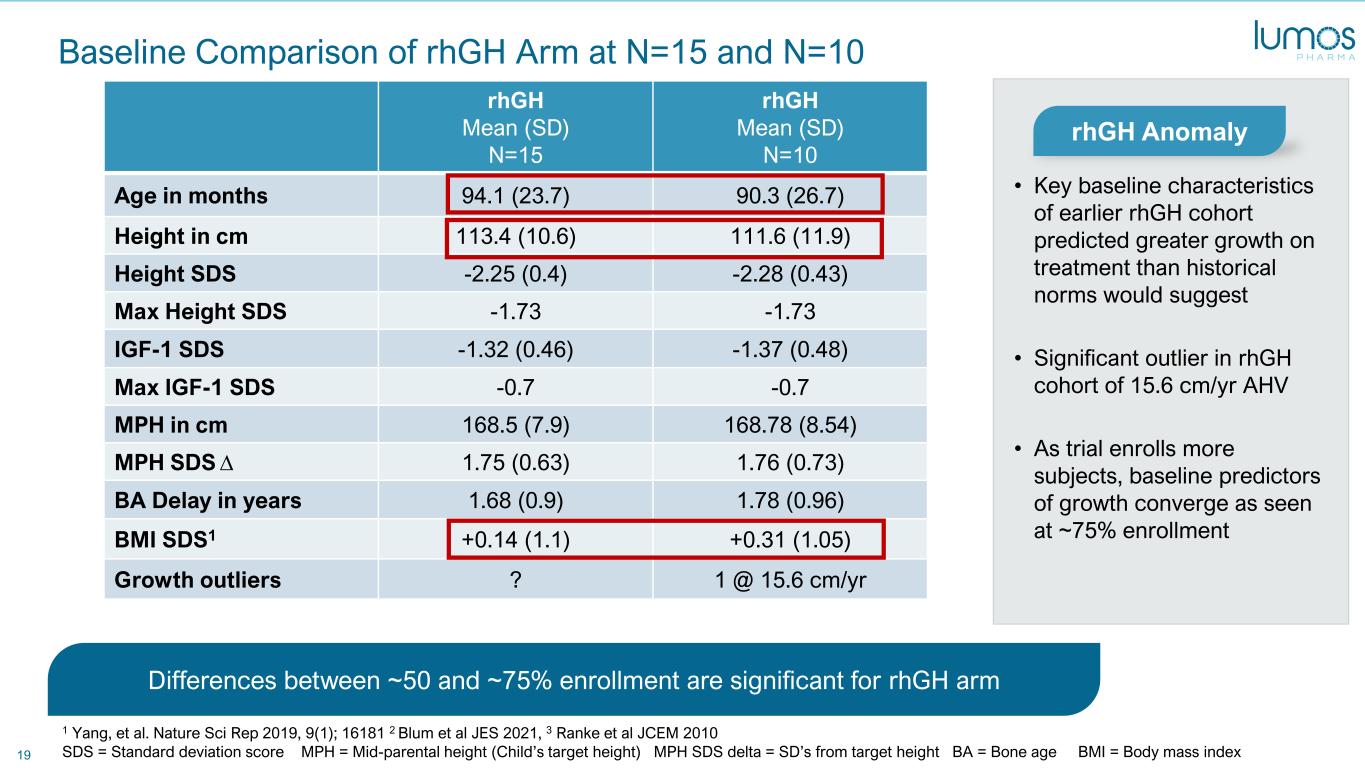
19 Baseline Comparison of rhGH Arm at N=15 and N=10 rhGH Mean (SD) N=15 rhGH Mean (SD) N=10 Age in months 94.1 (23.7) 90.3 (26.7) Height in cm 113.4 (10.6) 111.6 (11.9) Height SDS -2.25 (0.4) -2.28 (0.43) Max Height SDS -1.73 -1.73 IGF-1 SDS -1.32 (0.46) -1.37 (0.48) Max IGF-1 SDS -0.7 -0.7 MPH in cm 168.5 (7.9) 168.78 (8.54) MPH SDS∆ 1.75 (0.63) 1.76 (0.73) BA Delay in years 1.68 (0.9) 1.78 (0.96) BMI SDS1 +0.14 (1.1) +0.31 (1.05) Growth outliers ? 1 @ 15.6 cm/yr 1 Yang, et al. Nature Sci Rep 2019, 9(1); 16181 2 Blum et al JES 2021, 3 Ranke et al JCEM 2010 SDS = Standard deviation score MPH = Mid-parental height (Child’s target height) MPH SDS delta = SD’s from target height BA = Bone age BMI = Body mass index • Key baseline characteristics of earlier rhGH cohort predicted greater growth on treatment than historical norms would suggest • Significant outlier in rhGH cohort of 15.6 cm/yr AHV • As trial enrolls more subjects, baseline predictors of growth converge as seen at ~75% enrollment rhGH Anomaly Differences between ~50 and ~75% enrollment are significant for rhGH arm
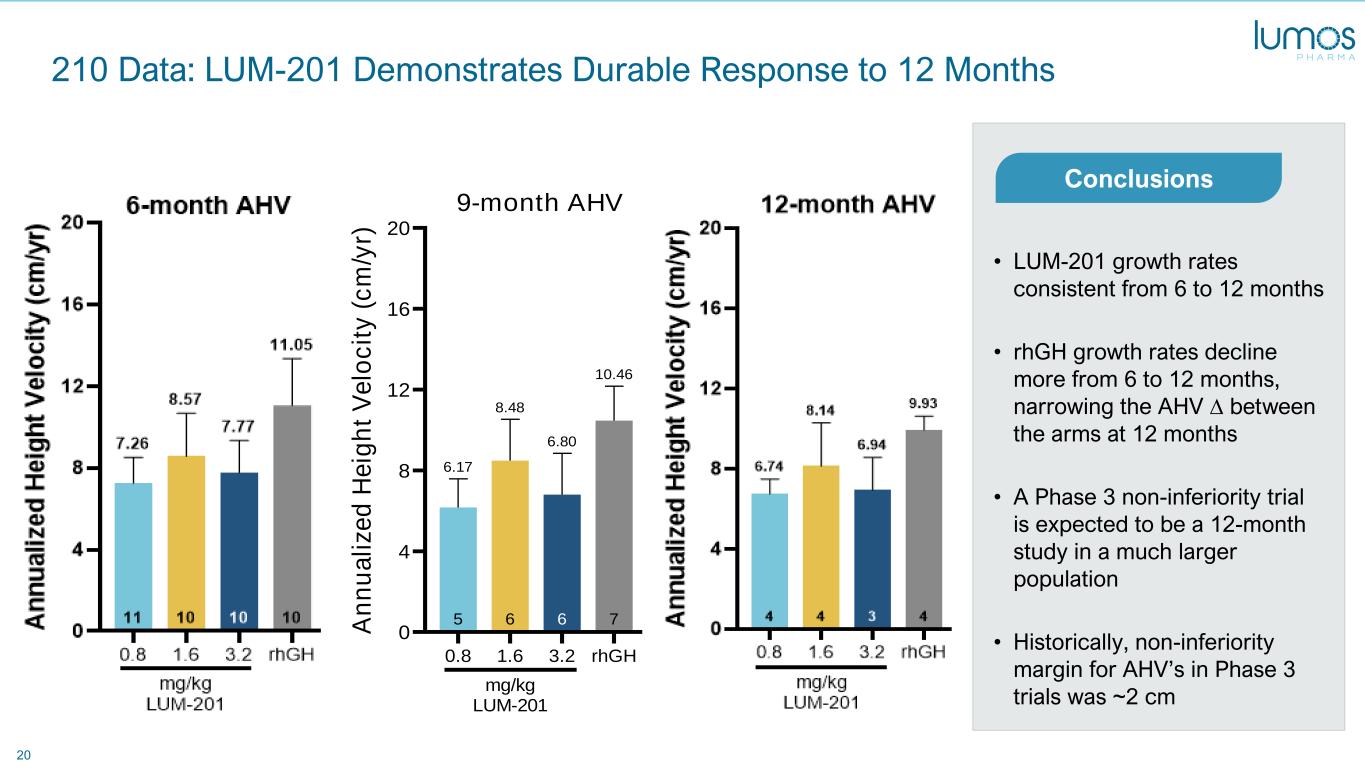
20 210 Data: LUM-201 Demonstrates Durable Response to 12 Months • LUM-201 growth rates consistent from 6 to 12 months • rhGH growth rates decline more from 6 to 12 months, narrowing the AHV ∆ between the arms at 12 months • A Phase 3 non-inferiority trial is expected to be a 12-month study in a much larger population • Historically, non-inferiority margin for AHV’s in Phase 3 trials was ~2 cm Conclusions 0.8 1.6 3.2 rhGH 0 4 8 12 16 20 7 10.46 6 6.80 6 8.48 5 6.17 A n n u a li z e d H e ig h t V e lo c it y ( c m /y r) 9-month AHV mg/kg LUM-201
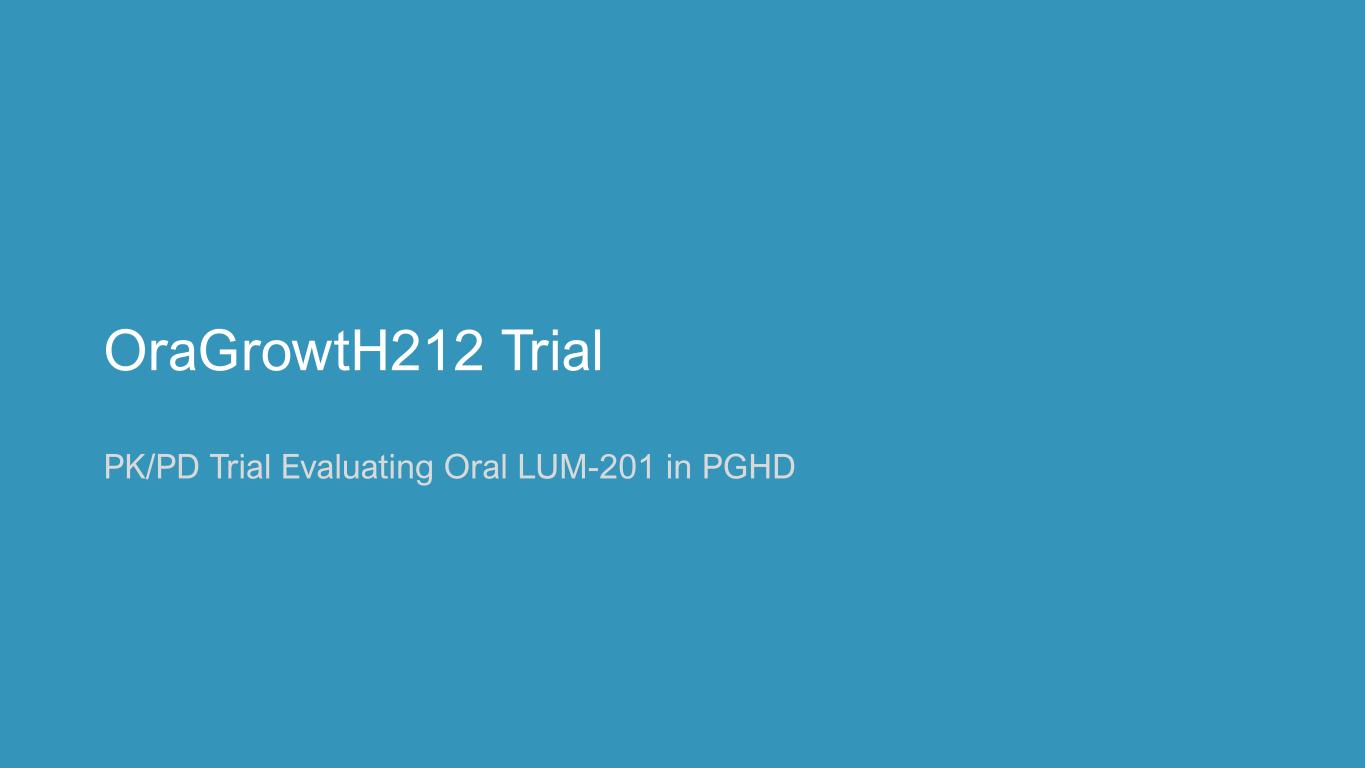
OraGrowtH212 Trial PK/PD Trial Evaluating Oral LUM-201 in PGHD
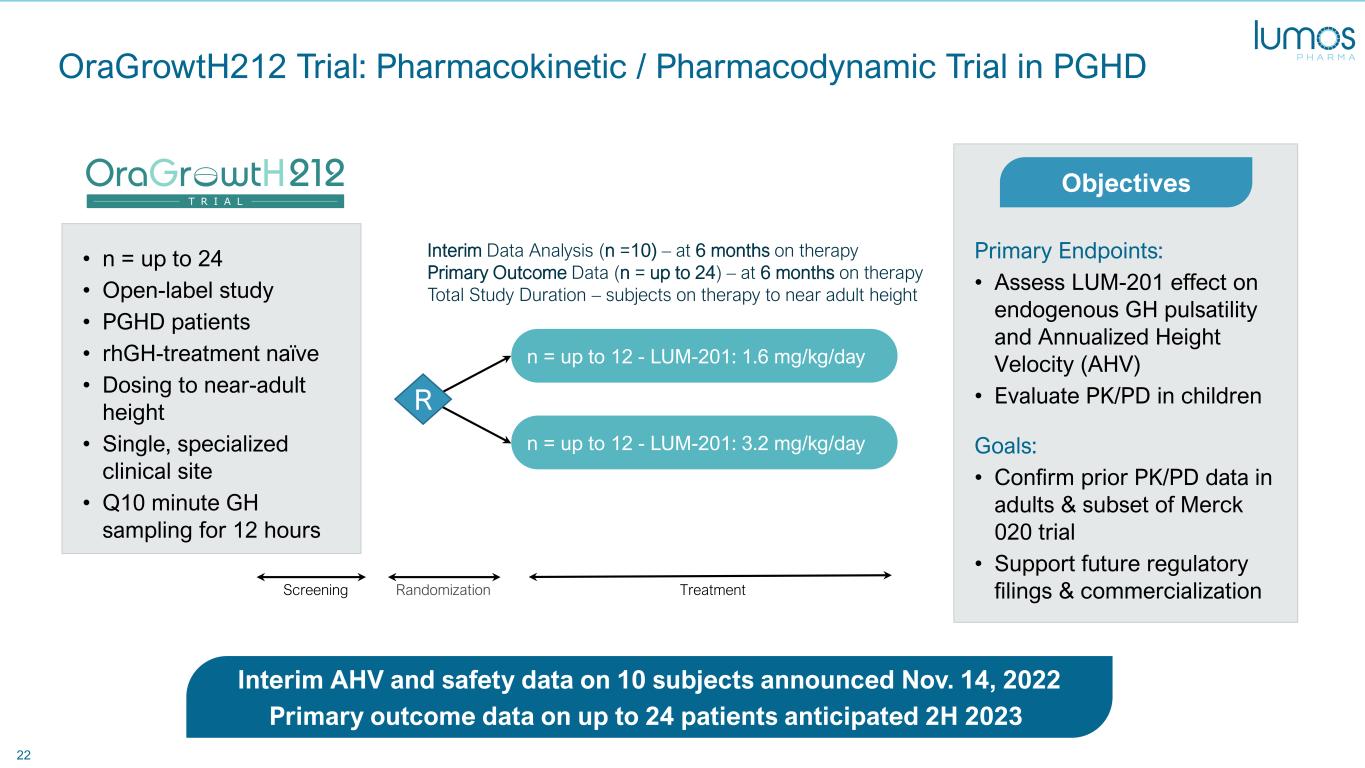
22 • n = up to 24 • Open-label study • PGHD patients • rhGH-treatment naïve • Dosing to near-adult height • Single, specialized clinical site • Q10 minute GH sampling for 12 hours OraGrowtH212 Trial: Pharmacokinetic / Pharmacodynamic Trial in PGHD Primary Endpoints: • Assess LUM-201 effect on endogenous GH pulsatility and Annualized Height Velocity (AHV) • Evaluate PK/PD in children Goals: • Confirm prior PK/PD data in adults & subset of Merck 020 trial • Support future regulatory filings & commercialization Interim AHV and safety data on 10 subjects announced Nov. 14, 2022 Primary outcome data on up to 24 patients anticipated 2H 2023 Objectives n = up to 12 - LUM-201: 3.2 mg/kg/day n = up to 12 - LUM-201: 1.6 mg/kg/day R TreatmentRandomizationScreening Interim Data Analysis (n =10) – at 6 months on therapy Primary Outcome Data (n = up to 24) – at 6 months on therapy Total Study Duration – subjects on therapy to near adult height

23 OraGrowtH212 & OraGrowtH210 Comparative AHVs at 6 Months • OraGrowtH212 Trial results showed a similar growth rate to OraGrowtH210 Trial • Anticipate fully enrolled datasets and larger N from both trials to strengthen these results • Anticipate larger Phase 3 trial to further support the LUM- 201 growth rate seen in OraGrowtH210 and OraGrowtH212 Conclusions
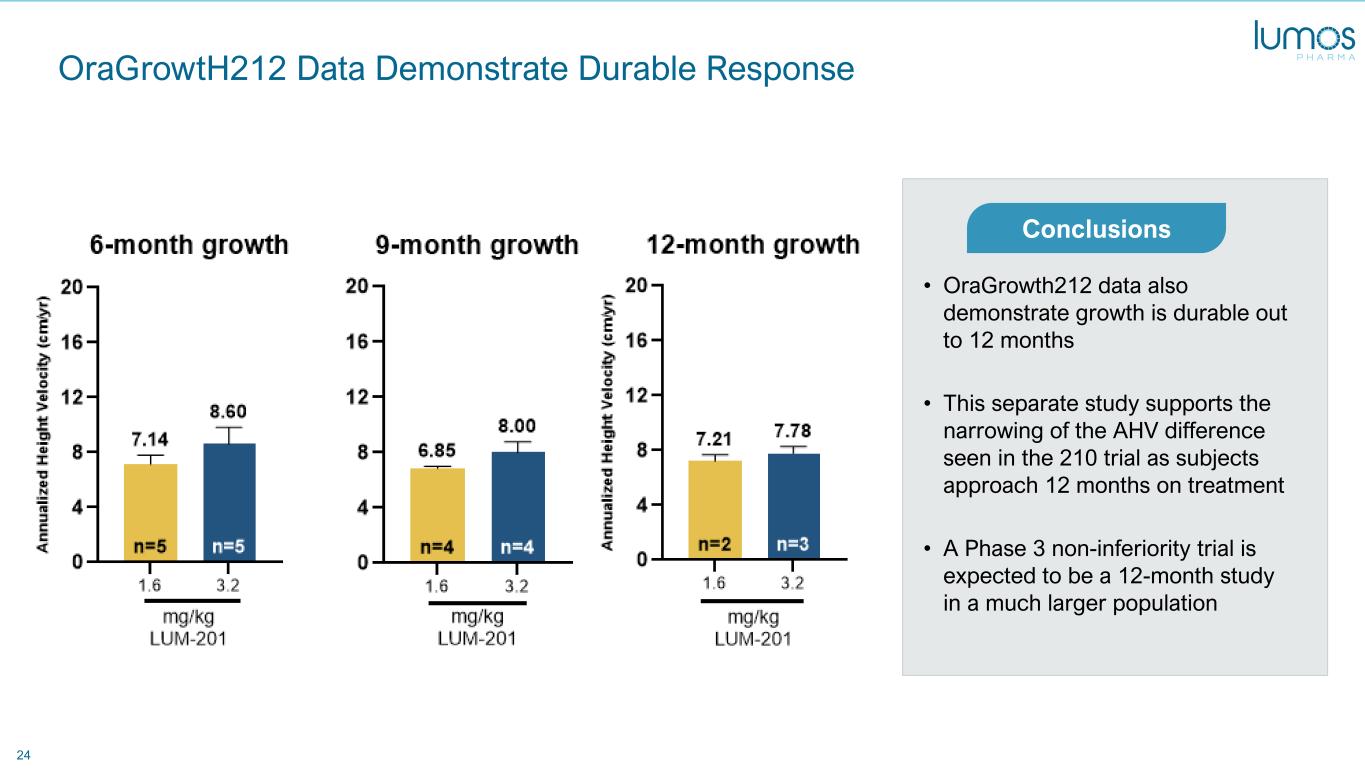
24 OraGrowtH212 Data Demonstrate Durable Response • OraGrowth212 data also demonstrate growth is durable out to 12 months • This separate study supports the narrowing of the AHV difference seen in the 210 trial as subjects approach 12 months on treatment • A Phase 3 non-inferiority trial is expected to be a 12-month study in a much larger population Conclusions
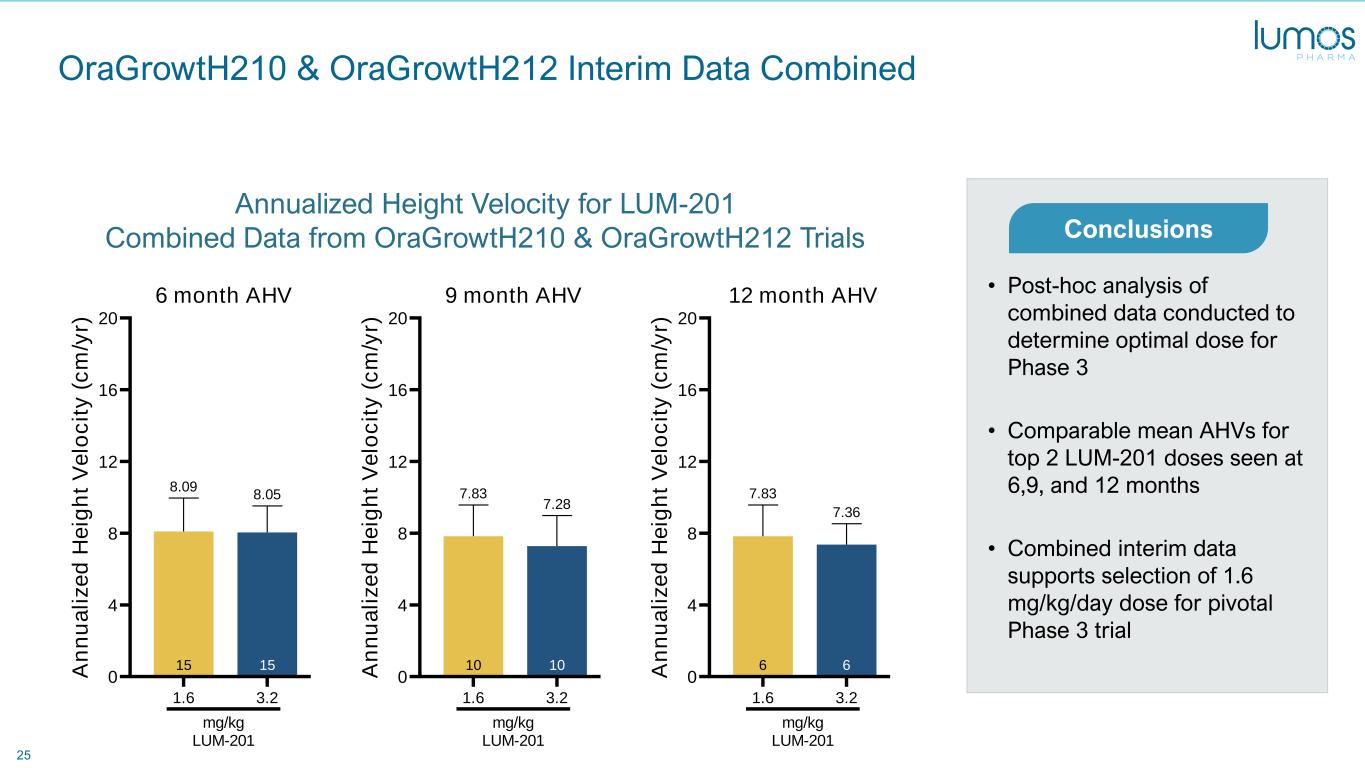
25 OraGrowtH210 & OraGrowtH212 Interim Data Combined • Post-hoc analysis of combined data conducted to determine optimal dose for Phase 3 • Comparable mean AHVs for top 2 LUM-201 doses seen at 6,9, and 12 months • Combined interim data supports selection of 1.6 mg/kg/day dose for pivotal Phase 3 trial Conclusions Annualized Height Velocity for LUM-201 Combined Data from OraGrowtH210 & OraGrowtH212 Trials 1.6 3.2 0 4 8 12 16 20 15 8.05 15 8.09 A n n u a li z e d H e ig h t V e lo c it y ( c m /y r) mg/kg LUM-201 6 month AHV 1.6 3.2 0 4 8 12 16 20 10 7.28 10 7.83 A n n u a li z e d H e ig h t V e lo c it y ( c m /y r) 9 month AHV mg/kg LUM-201 1.6 3.2 0 4 8 12 16 20 6 7.36 6 7.83 A n n u a li z e d H e ig h t V e lo c it y ( c m /y r) 12 month AHV mg/kg LUM-201

Safety and Tolerability
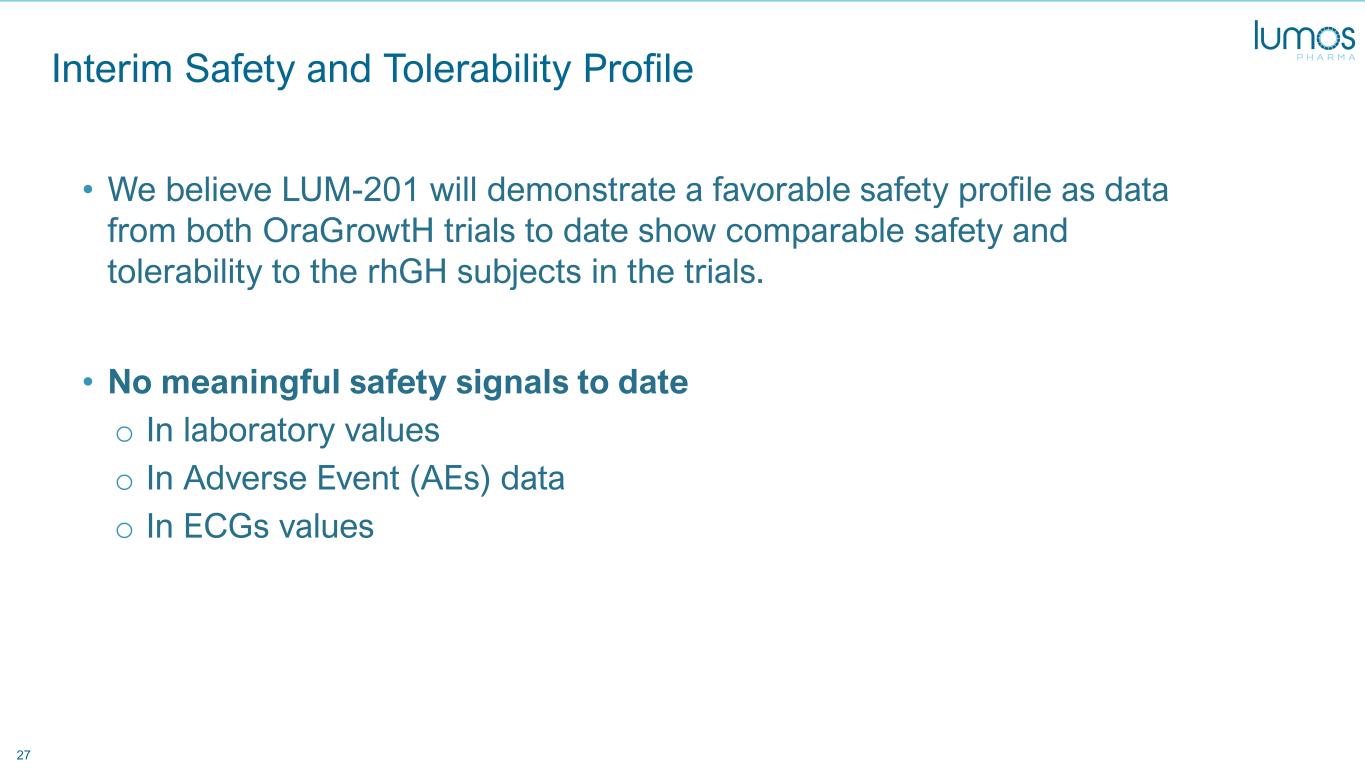
27 Interim Safety and Tolerability Profile • We believe LUM-201 will demonstrate a favorable safety profile as data from both OraGrowtH trials to date show comparable safety and tolerability to the rhGH subjects in the trials. • No meaningful safety signals to date o In laboratory values o In Adverse Event (AEs) data o In ECGs values

Financials
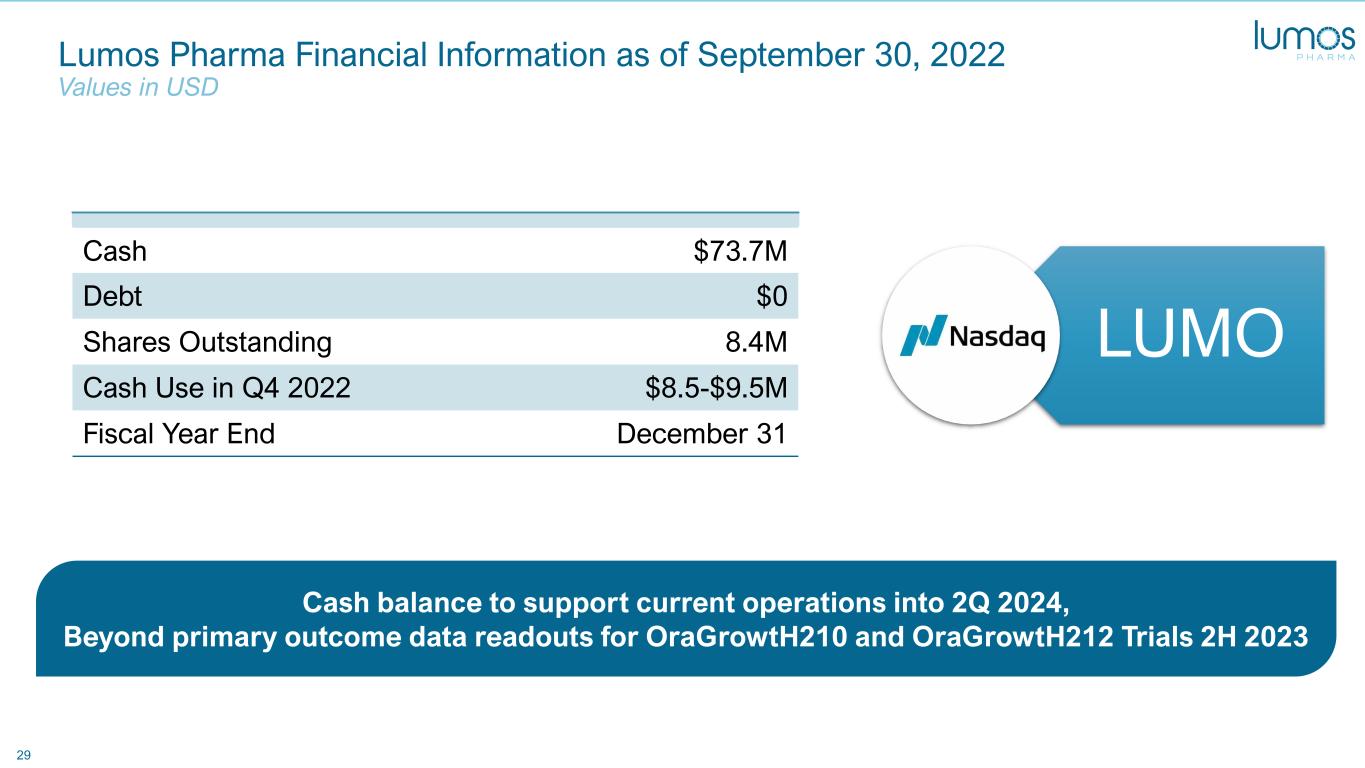
29 Lumos Pharma Financial Information as of September 30, 2022 Values in USD Cash $73.7M Debt $0 Shares Outstanding 8.4M Cash Use in Q4 2022 $8.5-$9.5M Fiscal Year End December 31 LUMO Cash balance to support current operations into 2Q 2024, Beyond primary outcome data readouts for OraGrowtH210 and OraGrowtH212 Trials 2H 2023

Conclusions
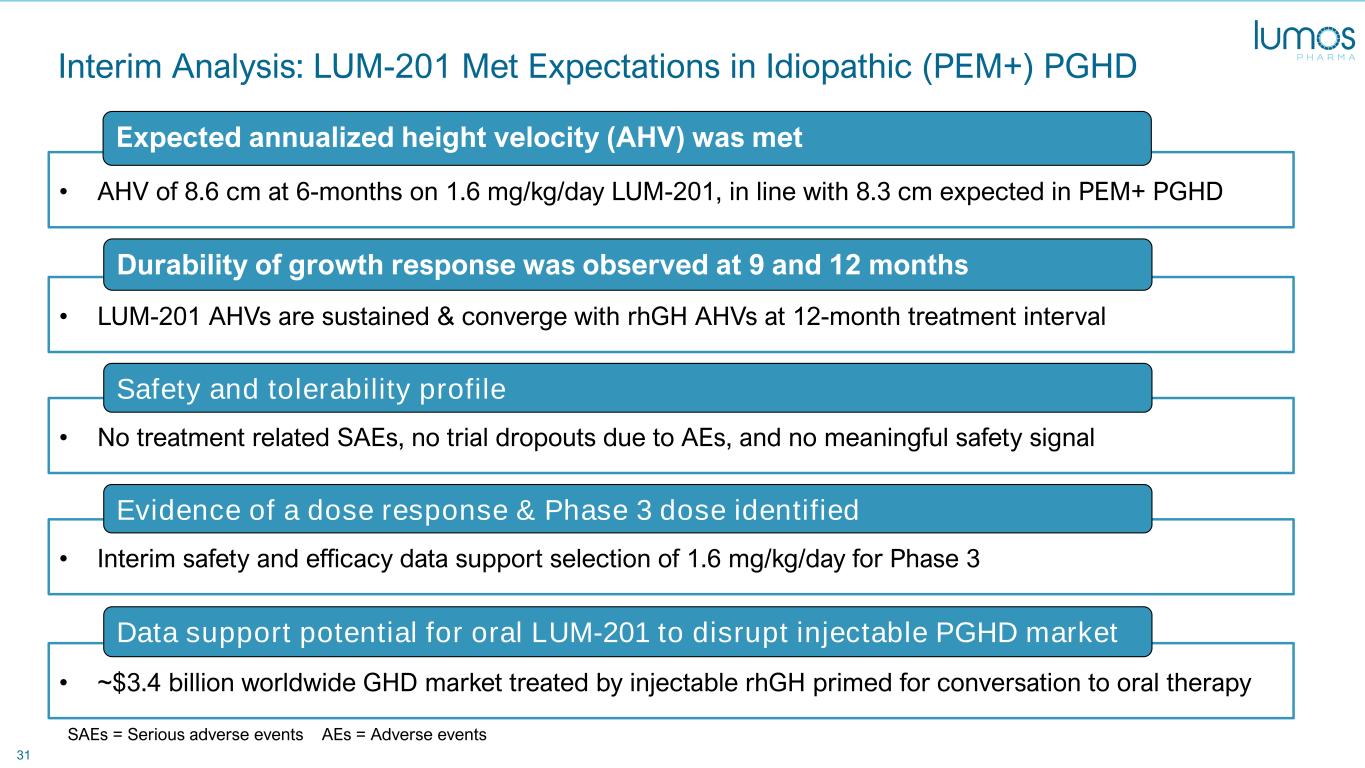
31 Interim Analysis: LUM-201 Met Expectations in Idiopathic (PEM+) PGHD SAEs = Serious adverse events AEs = Adverse events • AHV of 8.6 cm at 6-months on 1.6 mg/kg/day LUM-201, in line with 8.3 cm expected in PEM+ PGHD • LUM-201 AHVs are sustained & converge with rhGH AHVs at 12-month treatment interval • No treatment related SAEs, no trial dropouts due to AEs, and no meaningful safety signal • Interim safety and efficacy data support selection of 1.6 mg/kg/day for Phase 3 • ~$3.4 billion worldwide GHD market treated by injectable rhGH primed for conversation to oral therapy Expected annualized height velocity (AHV) was met Durability of growth response was observed at 9 and 12 months Safety and tolerability profile Evidence of a dose response & Phase 3 dose identified Data support potential for oral LUM-201 to disrupt injectable PGHD market

Interim Analysis Supplemental Materials
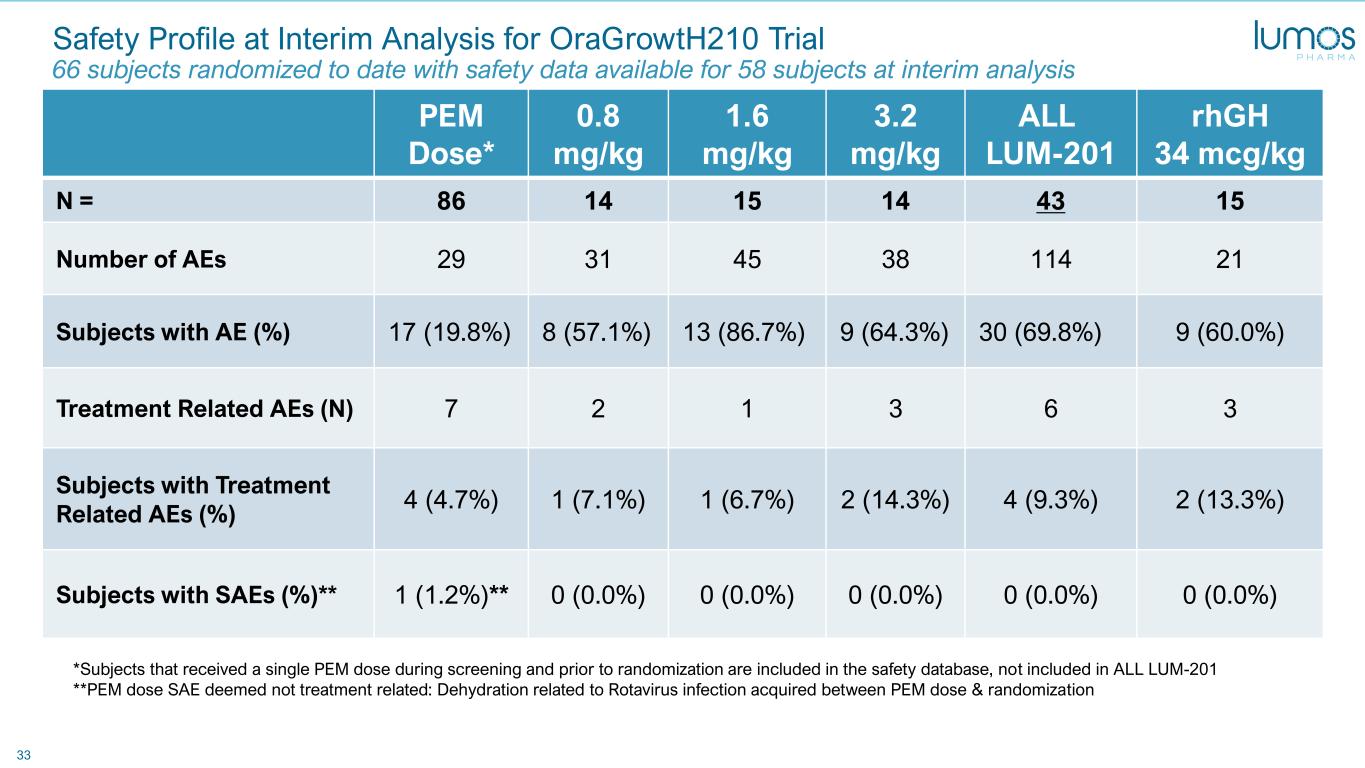
33 Safety Profile at Interim Analysis for OraGrowtH210 Trial 66 subjects randomized to date with safety data available for 58 subjects at interim analysis PEM Dose* 0.8 mg/kg 1.6 mg/kg 3.2 mg/kg ALL LUM-201 rhGH 34 mcg/kg N = 86 14 15 14 43 15 Number of AEs 29 31 45 38 114 21 Subjects with AE (%) 17 (19.8%) 8 (57.1%) 13 (86.7%) 9 (64.3%) 30 (69.8%) 9 (60.0%) Treatment Related AEs (N) 7 2 1 3 6 3 Subjects with Treatment Related AEs (%) 4 (4.7%) 1 (7.1%) 1 (6.7%) 2 (14.3%) 4 (9.3%) 2 (13.3%) Subjects with SAEs (%)** 1 (1.2%)** 0 (0.0%) 0 (0.0%) 0 (0.0%) 0 (0.0%) 0 (0.0%) *Subjects that received a single PEM dose during screening and prior to randomization are included in the safety database, not included in ALL LUM-201 **PEM dose SAE deemed not treatment related: Dehydration related to Rotavirus infection acquired between PEM dose & randomization
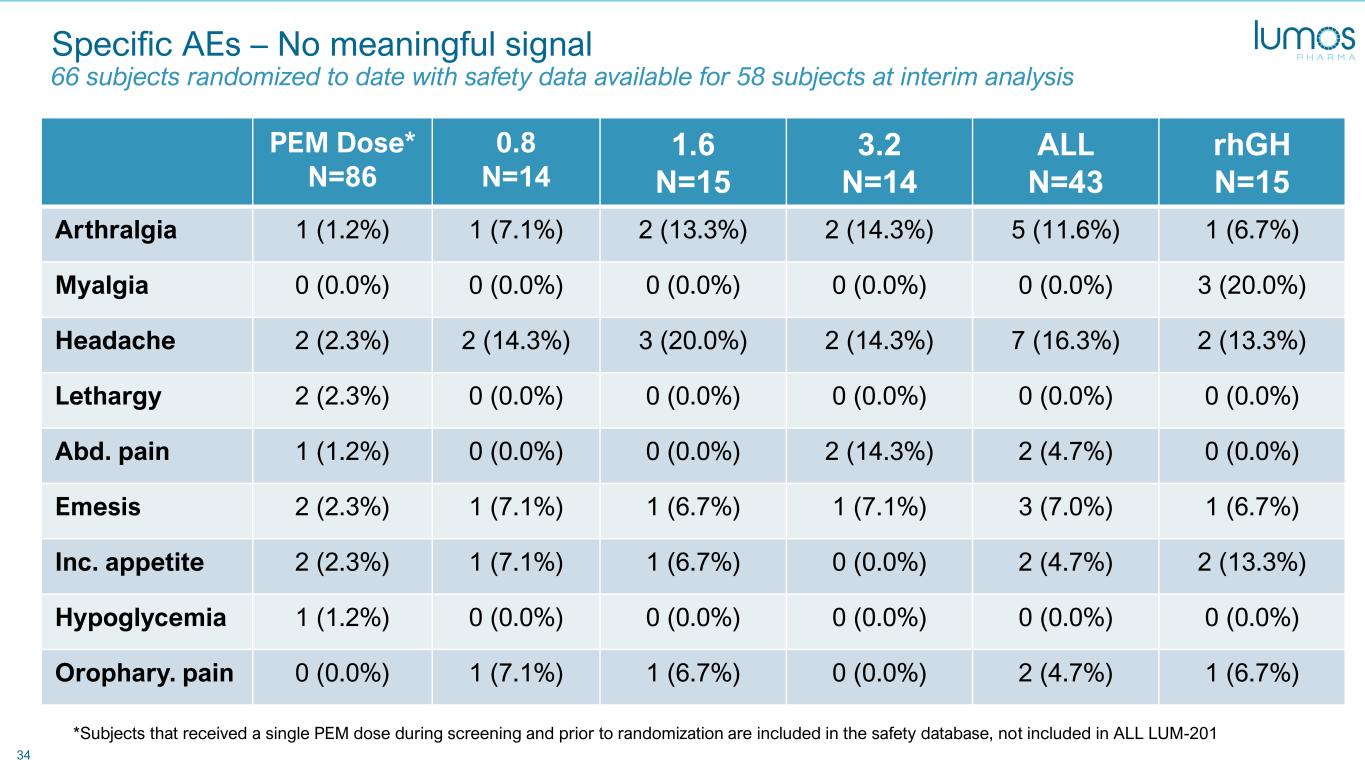
34 Specific AEs – No meaningful signal 66 subjects randomized to date with safety data available for 58 subjects at interim analysis PEM Dose* N=86 0.8 N=14 1.6 N=15 3.2 N=14 ALL N=43 rhGH N=15 Arthralgia 1 (1.2%) 1 (7.1%) 2 (13.3%) 2 (14.3%) 5 (11.6%) 1 (6.7%) Myalgia 0 (0.0%) 0 (0.0%) 0 (0.0%) 0 (0.0%) 0 (0.0%) 3 (20.0%) Headache 2 (2.3%) 2 (14.3%) 3 (20.0%) 2 (14.3%) 7 (16.3%) 2 (13.3%) Lethargy 2 (2.3%) 0 (0.0%) 0 (0.0%) 0 (0.0%) 0 (0.0%) 0 (0.0%) Abd. pain 1 (1.2%) 0 (0.0%) 0 (0.0%) 2 (14.3%) 2 (4.7%) 0 (0.0%) Emesis 2 (2.3%) 1 (7.1%) 1 (6.7%) 1 (7.1%) 3 (7.0%) 1 (6.7%) Inc. appetite 2 (2.3%) 1 (7.1%) 1 (6.7%) 0 (0.0%) 2 (4.7%) 2 (13.3%) Hypoglycemia 1 (1.2%) 0 (0.0%) 0 (0.0%) 0 (0.0%) 0 (0.0%) 0 (0.0%) Orophary. pain 0 (0.0%) 1 (7.1%) 1 (6.7%) 0 (0.0%) 2 (4.7%) 1 (6.7%) *Subjects that received a single PEM dose during screening and prior to randomization are included in the safety database, not included in ALL LUM-201
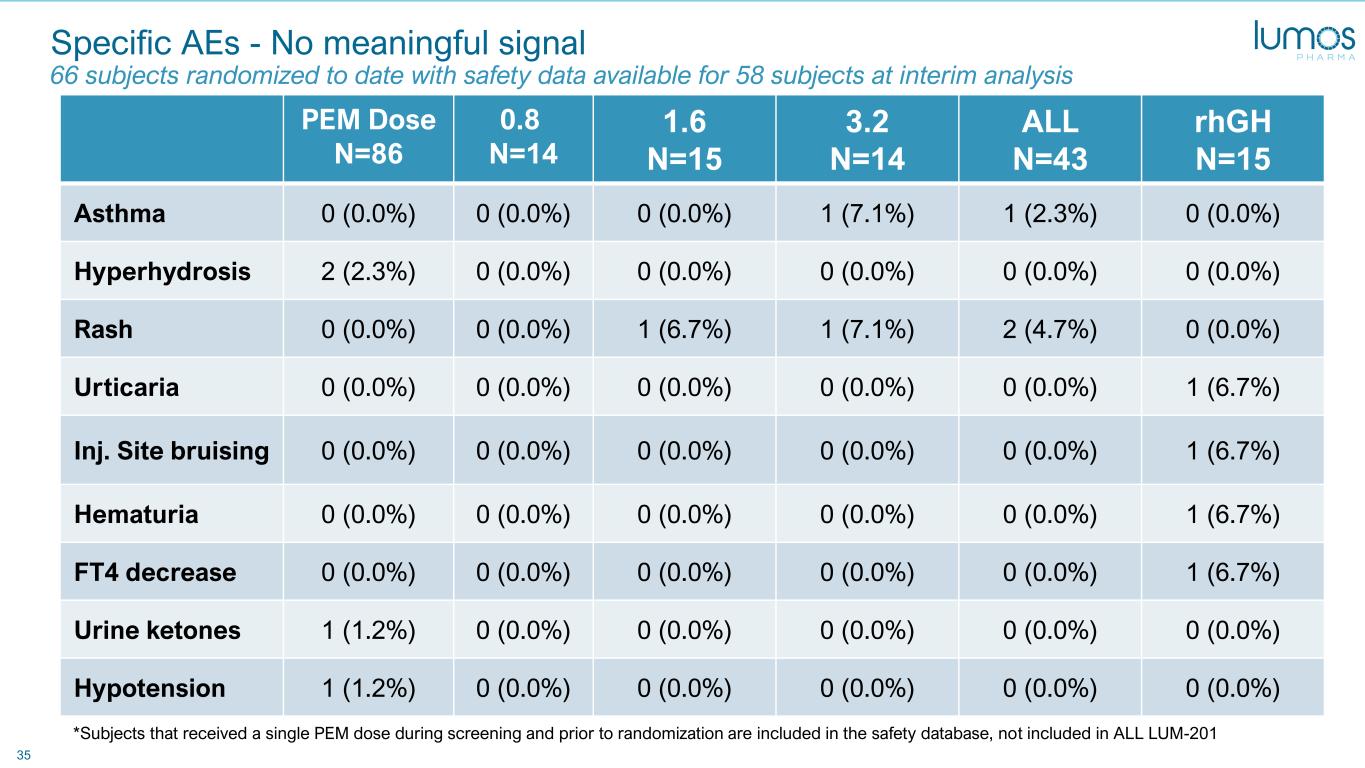
35 Specific AEs - No meaningful signal 66 subjects randomized to date with safety data available for 58 subjects at interim analysis PEM Dose N=86 0.8 N=14 1.6 N=15 3.2 N=14 ALL N=43 rhGH N=15 Asthma 0 (0.0%) 0 (0.0%) 0 (0.0%) 1 (7.1%) 1 (2.3%) 0 (0.0%) Hyperhydrosis 2 (2.3%) 0 (0.0%) 0 (0.0%) 0 (0.0%) 0 (0.0%) 0 (0.0%) Rash 0 (0.0%) 0 (0.0%) 1 (6.7%) 1 (7.1%) 2 (4.7%) 0 (0.0%) Urticaria 0 (0.0%) 0 (0.0%) 0 (0.0%) 0 (0.0%) 0 (0.0%) 1 (6.7%) Inj. Site bruising 0 (0.0%) 0 (0.0%) 0 (0.0%) 0 (0.0%) 0 (0.0%) 1 (6.7%) Hematuria 0 (0.0%) 0 (0.0%) 0 (0.0%) 0 (0.0%) 0 (0.0%) 1 (6.7%) FT4 decrease 0 (0.0%) 0 (0.0%) 0 (0.0%) 0 (0.0%) 0 (0.0%) 1 (6.7%) Urine ketones 1 (1.2%) 0 (0.0%) 0 (0.0%) 0 (0.0%) 0 (0.0%) 0 (0.0%) Hypotension 1 (1.2%) 0 (0.0%) 0 (0.0%) 0 (0.0%) 0 (0.0%) 0 (0.0%) *Subjects that received a single PEM dose during screening and prior to randomization are included in the safety database, not included in ALL LUM-201
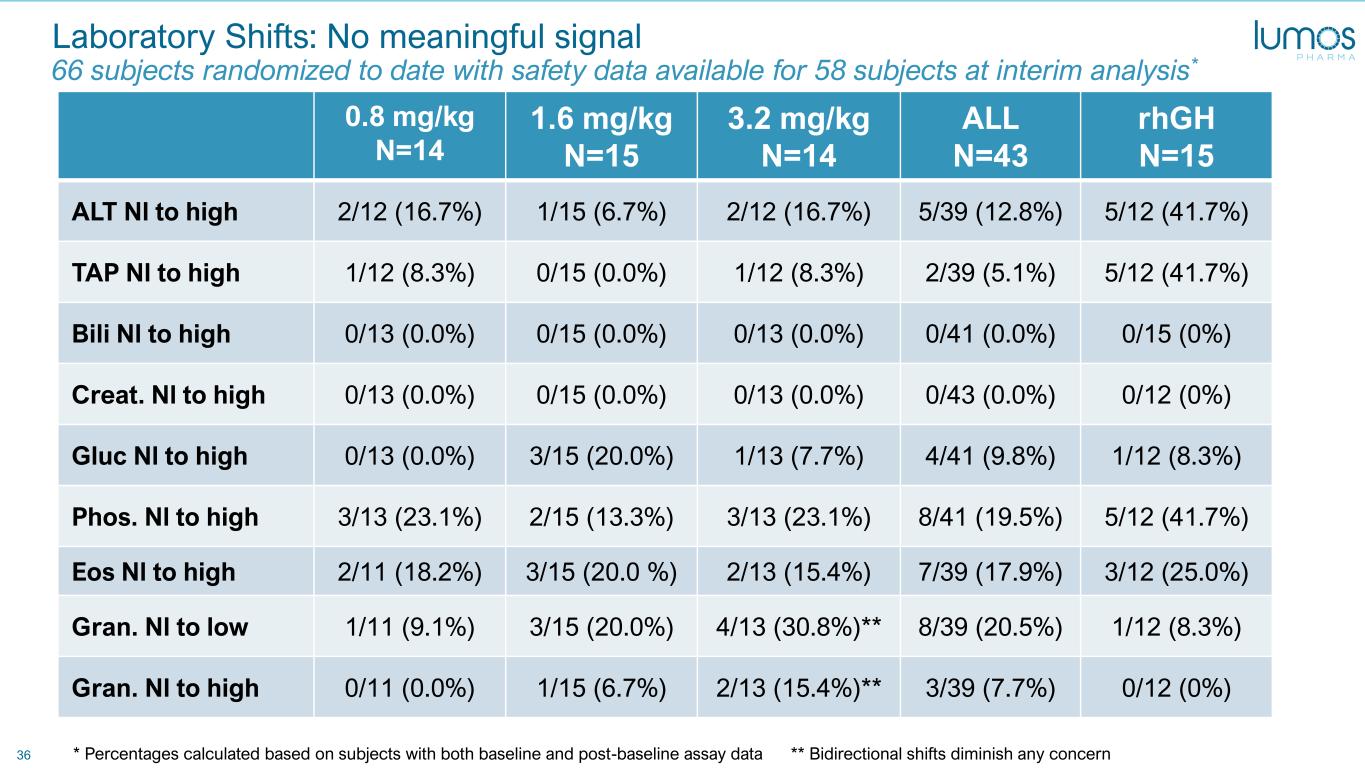
36 * Percentages calculated based on subjects with both baseline and post-baseline assay data ** Bidirectional shifts diminish any concern Laboratory Shifts: No meaningful signal 66 subjects randomized to date with safety data available for 58 subjects at interim analysis* 0.8 mg/kg N=14 1.6 mg/kg N=15 3.2 mg/kg N=14 ALL N=43 rhGH N=15 ALT Nl to high 2/12 (16.7%) 1/15 (6.7%) 2/12 (16.7%) 5/39 (12.8%) 5/12 (41.7%) TAP Nl to high 1/12 (8.3%) 0/15 (0.0%) 1/12 (8.3%) 2/39 (5.1%) 5/12 (41.7%) Bili Nl to high 0/13 (0.0%) 0/15 (0.0%) 0/13 (0.0%) 0/41 (0.0%) 0/15 (0%) Creat. Nl to high 0/13 (0.0%) 0/15 (0.0%) 0/13 (0.0%) 0/43 (0.0%) 0/12 (0%) Gluc Nl to high 0/13 (0.0%) 3/15 (20.0%) 1/13 (7.7%) 4/41 (9.8%) 1/12 (8.3%) Phos. Nl to high 3/13 (23.1%) 2/15 (13.3%) 3/13 (23.1%) 8/41 (19.5%) 5/12 (41.7%) Eos Nl to high 2/11 (18.2%) 3/15 (20.0 %) 2/13 (15.4%) 7/39 (17.9%) 3/12 (25.0%) Gran. Nl to low 1/11 (9.1%) 3/15 (20.0%) 4/13 (30.8%)** 8/39 (20.5%) 1/12 (8.3%) Gran. Nl to high 0/11 (0.0%) 1/15 (6.7%) 2/13 (15.4%)** 3/39 (7.7%) 0/12 (0%)
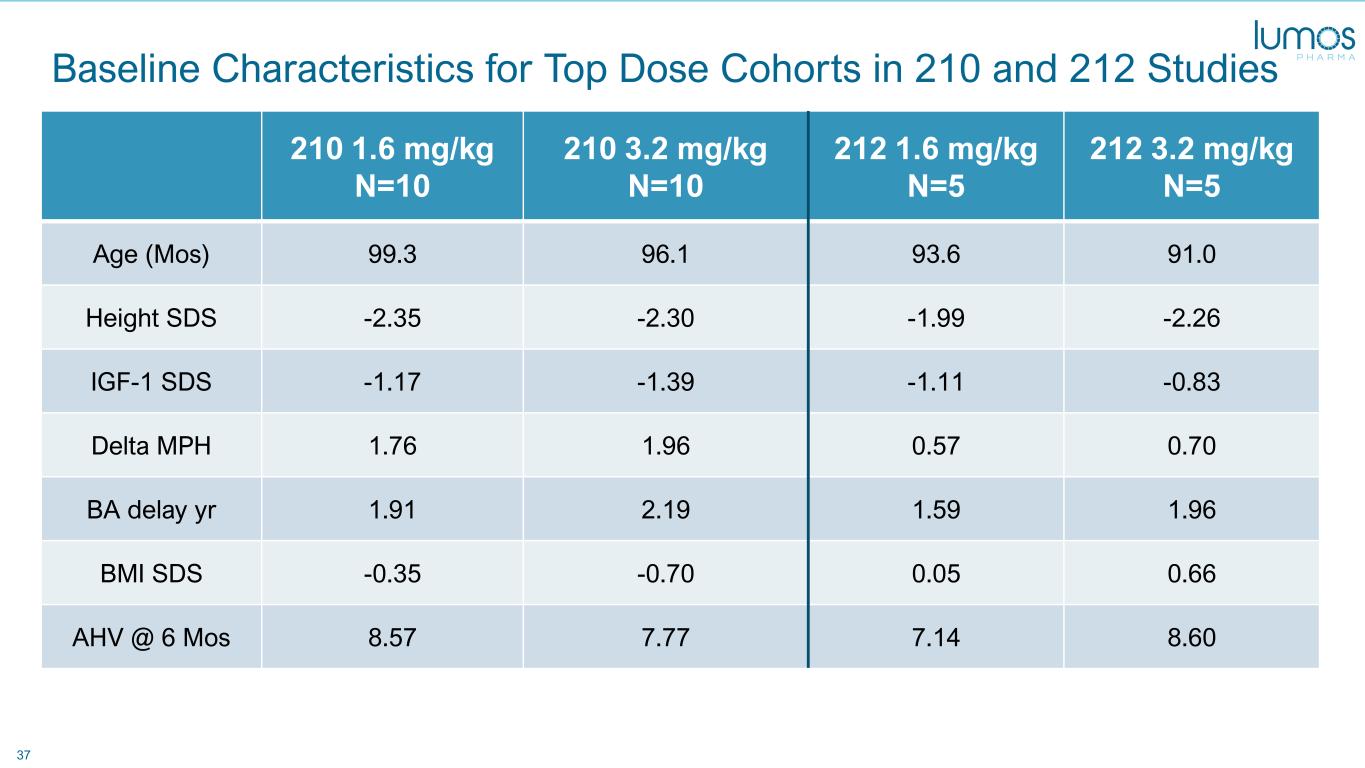
37 Baseline Characteristics for Top Dose Cohorts in 210 and 212 Studies 210 1.6 mg/kg N=10 210 3.2 mg/kg N=10 212 1.6 mg/kg N=5 212 3.2 mg/kg N=5 Age (Mos) 99.3 96.1 93.6 91.0 Height SDS -2.35 -2.30 -1.99 -2.26 IGF-1 SDS -1.17 -1.39 -1.11 -0.83 Delta MPH 1.76 1.96 0.57 0.70 BA delay yr 1.91 2.19 1.59 1.96 BMI SDS -0.35 -0.70 0.05 0.66 AHV @ 6 Mos 8.57 7.77 7.14 8.60
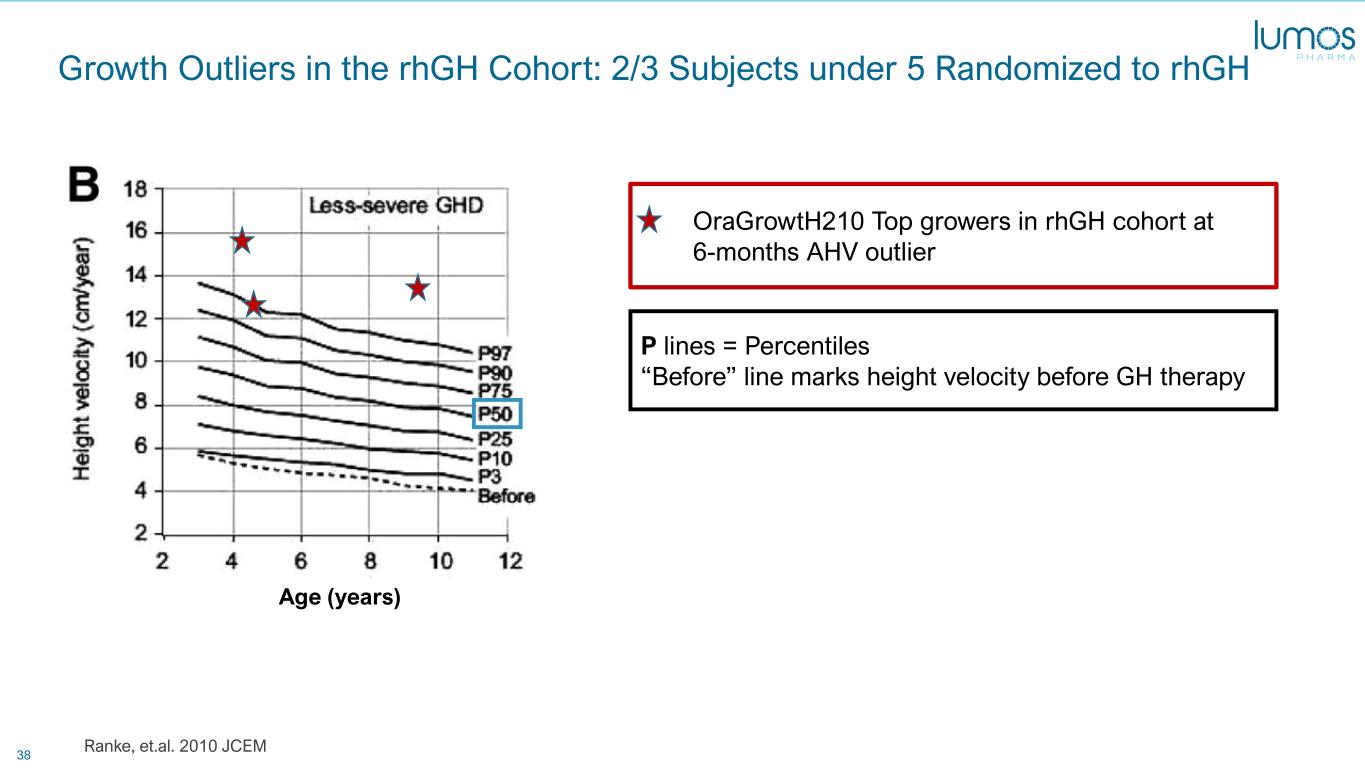
38 Age (years) Growth Outliers in the rhGH Cohort: 2/3 Subjects under 5 Randomized to rhGH Ranke, et.al. 2010 JCEM OraGrowtH210 Top growers in rhGH cohort at 6-months AHV outlier P lines = Percentiles “Before” line marks height velocity before GH therapy
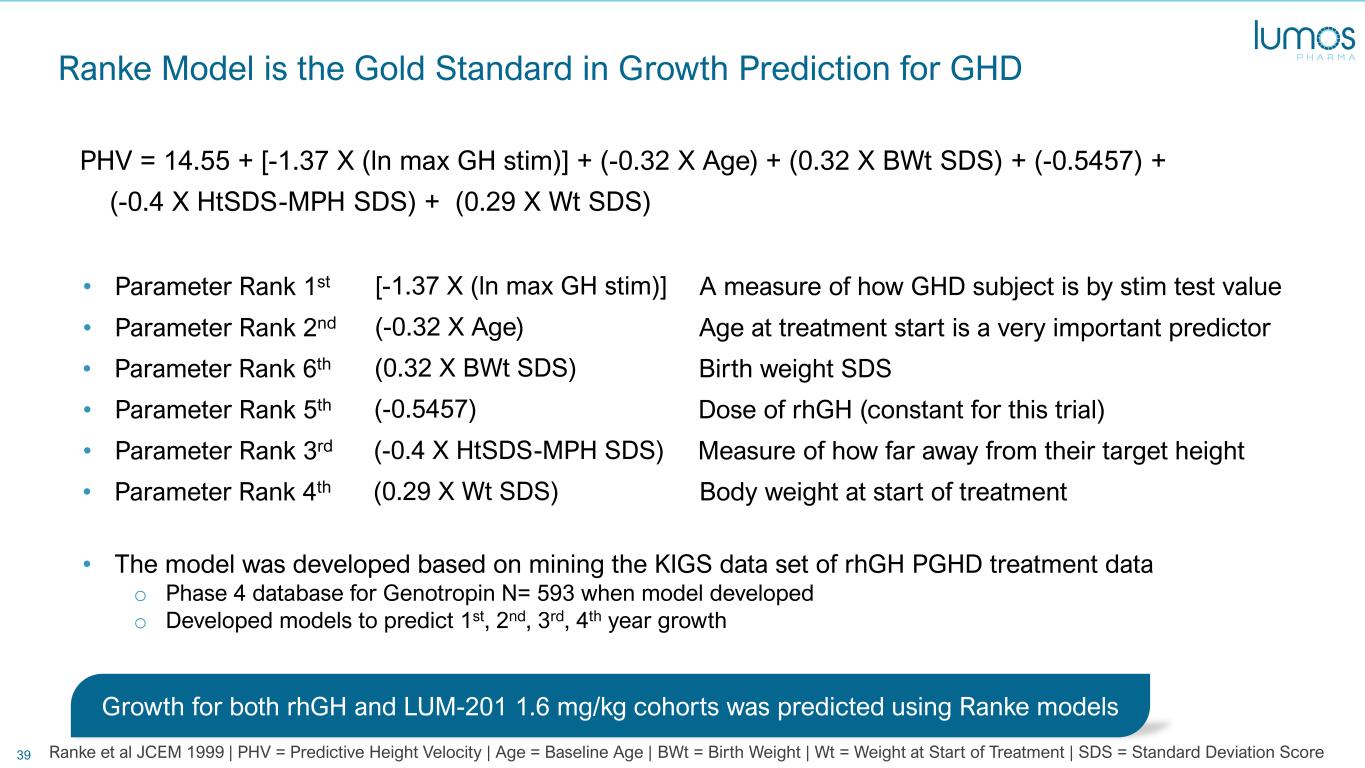
39 Ranke Model is the Gold Standard in Growth Prediction for GHD PHV = 14.55 + [-1.37 X (ln max GH stim)] + (-0.32 X Age) + (0.32 X BWt SDS) + (-0.5457) + (-0.4 X HtSDS-MPH SDS) + (0.29 X Wt SDS) [-1.37 X (ln max GH stim)]• Parameter Rank 1st A measure of how GHD subject is by stim test value (-0.32 X Age)• Parameter Rank 2nd Age at treatment start is a very important predictor (0.32 X BWt SDS)• Parameter Rank 6th Birth weight SDS (-0.5457)• Parameter Rank 5th Dose of rhGH (constant for this trial) (-0.4 X HtSDS-MPH SDS)• Parameter Rank 3rd Measure of how far away from their target height (0.29 X Wt SDS)• Parameter Rank 4th Body weight at start of treatment • The model was developed based on mining the KIGS data set of rhGH PGHD treatment data o Phase 4 database for Genotropin N= 593 when model developed o Developed models to predict 1st, 2nd, 3rd, 4th year growth Growth for both rhGH and LUM-201 1.6 mg/kg cohorts was predicted using Ranke models Ranke et al JCEM 1999 | PHV = Predictive Height Velocity | Age = Baseline Age | BWt = Birth Weight | Wt = Weight at Start of Treatment | SDS = Standard Deviation Score
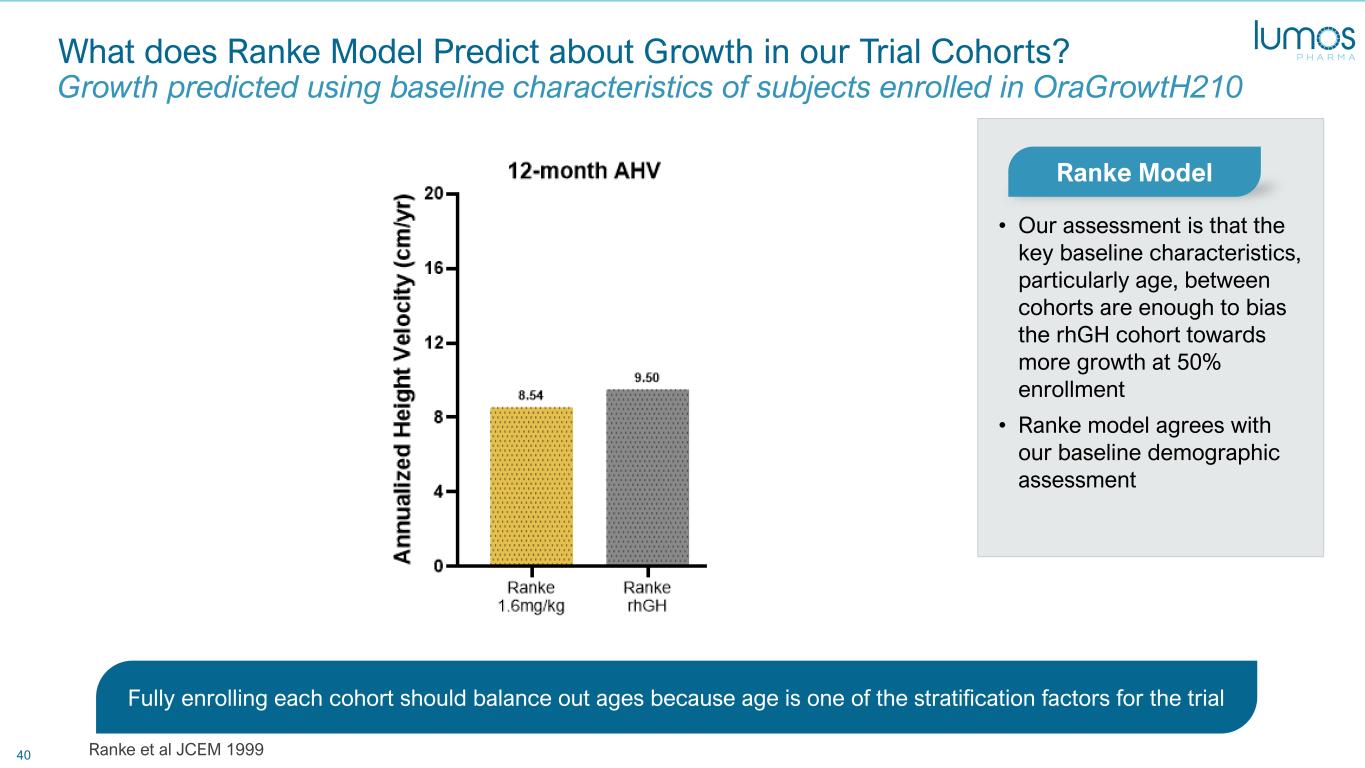
40 What does Ranke Model Predict about Growth in our Trial Cohorts? Growth predicted using baseline characteristics of subjects enrolled in OraGrowtH210 • Our assessment is that the key baseline characteristics, particularly age, between cohorts are enough to bias the rhGH cohort towards more growth at 50% enrollment • Ranke model agrees with our baseline demographic assessment Ranke Model Fully enrolling each cohort should balance out ages because age is one of the stratification factors for the trial Ranke et al JCEM 1999
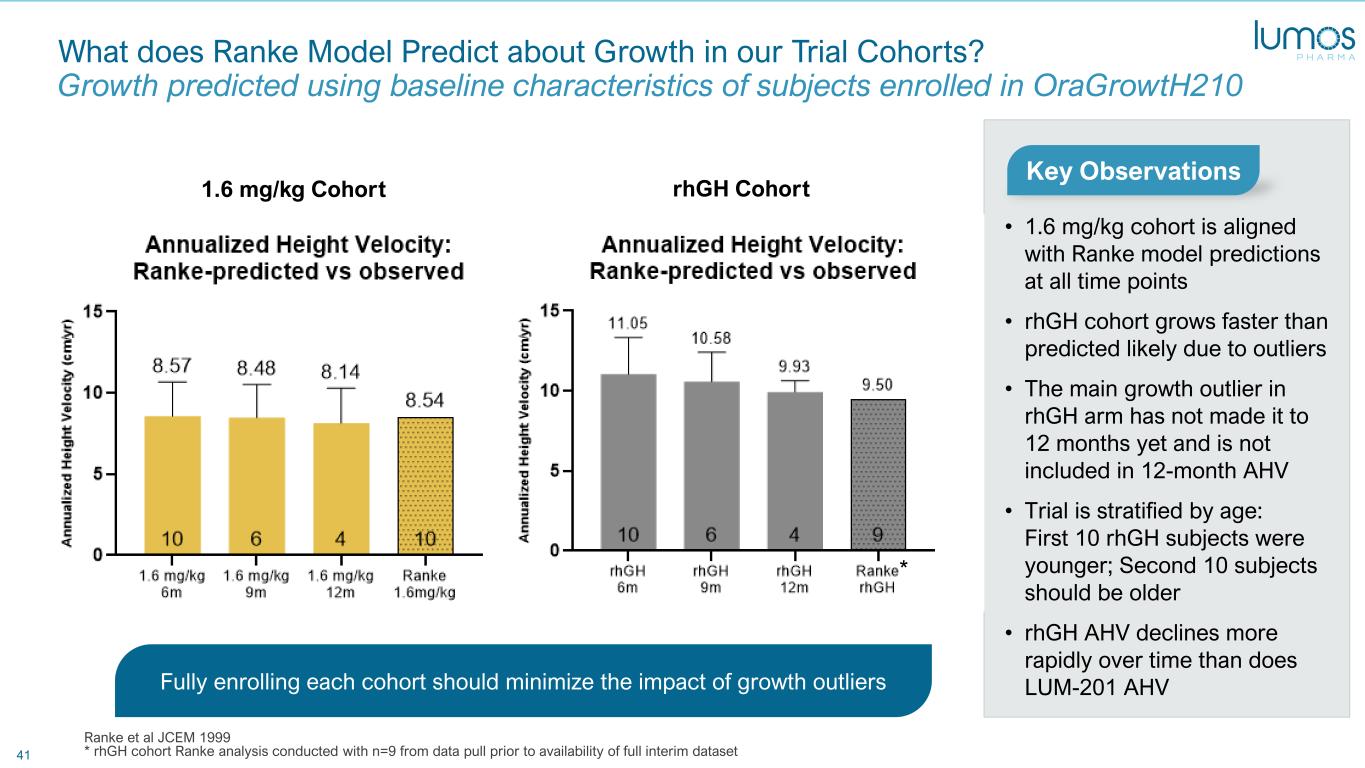
41 What does Ranke Model Predict about Growth in our Trial Cohorts? Growth predicted using baseline characteristics of subjects enrolled in OraGrowtH210 • 1.6 mg/kg cohort is aligned with Ranke model predictions at all time points • rhGH cohort grows faster than predicted likely due to outliers • The main growth outlier in rhGH arm has not made it to 12 months yet and is not included in 12-month AHV • Trial is stratified by age: First 10 rhGH subjects were younger; Second 10 subjects should be older • rhGH AHV declines more rapidly over time than does LUM-201 AHV Key Observations Fully enrolling each cohort should minimize the impact of growth outliers 1.6 mg/kg Cohort rhGH Cohort Ranke et al JCEM 1999 * rhGH cohort Ranke analysis conducted with n=9 from data pull prior to availability of full interim dataset *
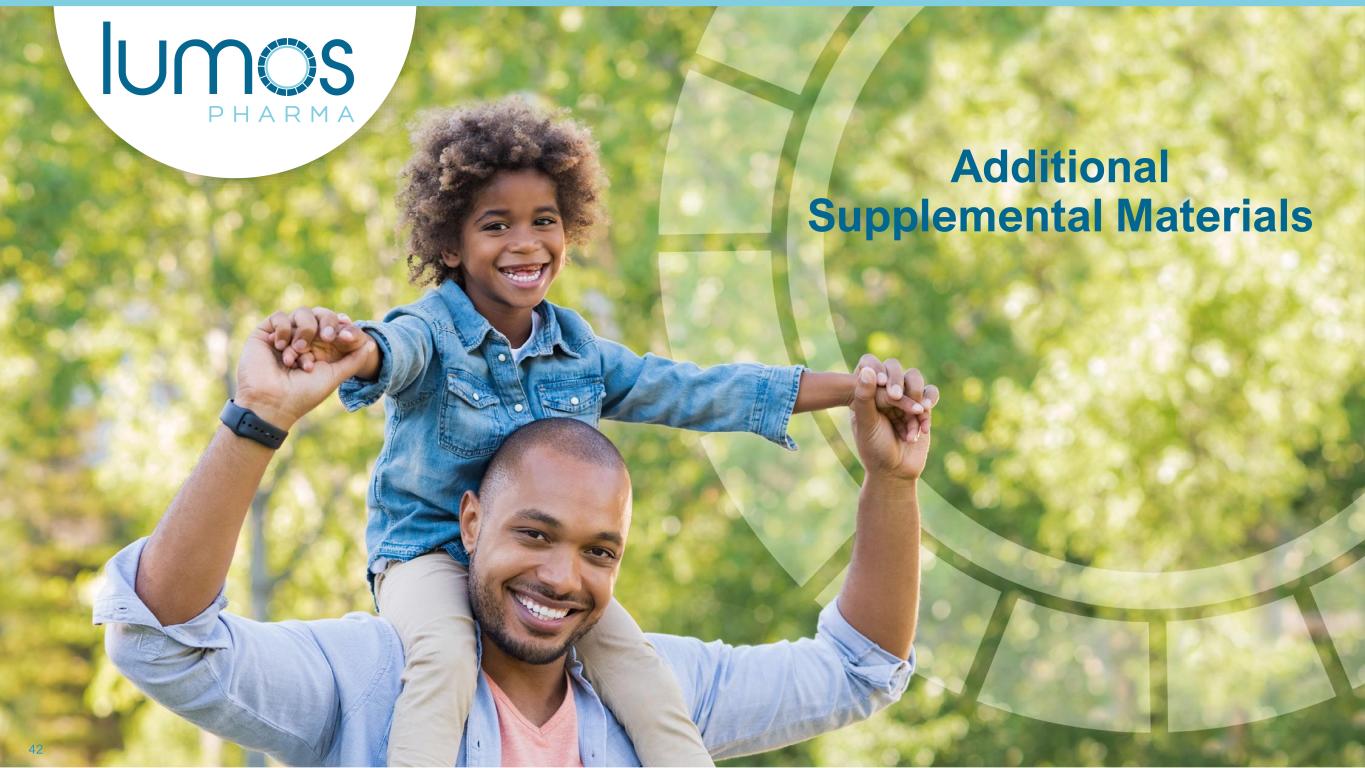
42 Additional Supplemental Materials
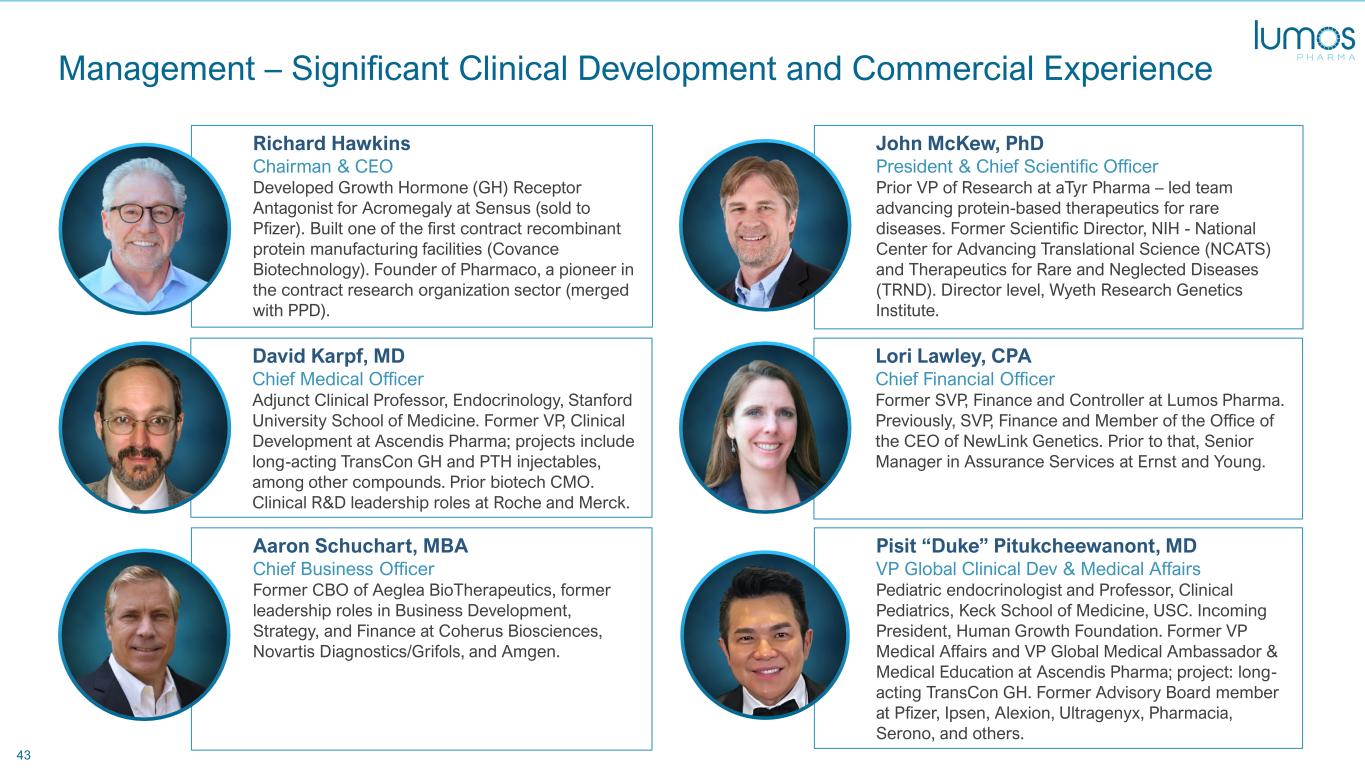
43 Management – Significant Clinical Development and Commercial Experience Richard Hawkins Chairman & CEO Developed Growth Hormone (GH) Receptor Antagonist for Acromegaly at Sensus (sold to Pfizer). Built one of the first contract recombinant protein manufacturing facilities (Covance Biotechnology). Founder of Pharmaco, a pioneer in the contract research organization sector (merged with PPD). John McKew, PhD President & Chief Scientific Officer Prior VP of Research at aTyr Pharma – led team advancing protein-based therapeutics for rare diseases. Former Scientific Director, NIH - National Center for Advancing Translational Science (NCATS) and Therapeutics for Rare and Neglected Diseases (TRND). Director level, Wyeth Research Genetics Institute. David Karpf, MD Chief Medical Officer Adjunct Clinical Professor, Endocrinology, Stanford University School of Medicine. Former VP, Clinical Development at Ascendis Pharma; projects include long-acting TransCon GH and PTH injectables, among other compounds. Prior biotech CMO. Clinical R&D leadership roles at Roche and Merck. Lori Lawley, CPA Chief Financial Officer Former SVP, Finance and Controller at Lumos Pharma. Previously, SVP, Finance and Member of the Office of the CEO of NewLink Genetics. Prior to that, Senior Manager in Assurance Services at Ernst and Young. Aaron Schuchart, MBA Chief Business Officer Former CBO of Aeglea BioTherapeutics, former leadership roles in Business Development, Strategy, and Finance at Coherus Biosciences, Novartis Diagnostics/Grifols, and Amgen. Pisit “Duke” Pitukcheewanont, MD VP Global Clinical Dev & Medical Affairs Pediatric endocrinologist and Professor, Clinical Pediatrics, Keck School of Medicine, USC. Incoming President, Human Growth Foundation. Former VP Medical Affairs and VP Global Medical Ambassador & Medical Education at Ascendis Pharma; project: long- acting TransCon GH. Former Advisory Board member at Pfizer, Ipsen, Alexion, Ultragenyx, Pharmacia, Serono, and others.
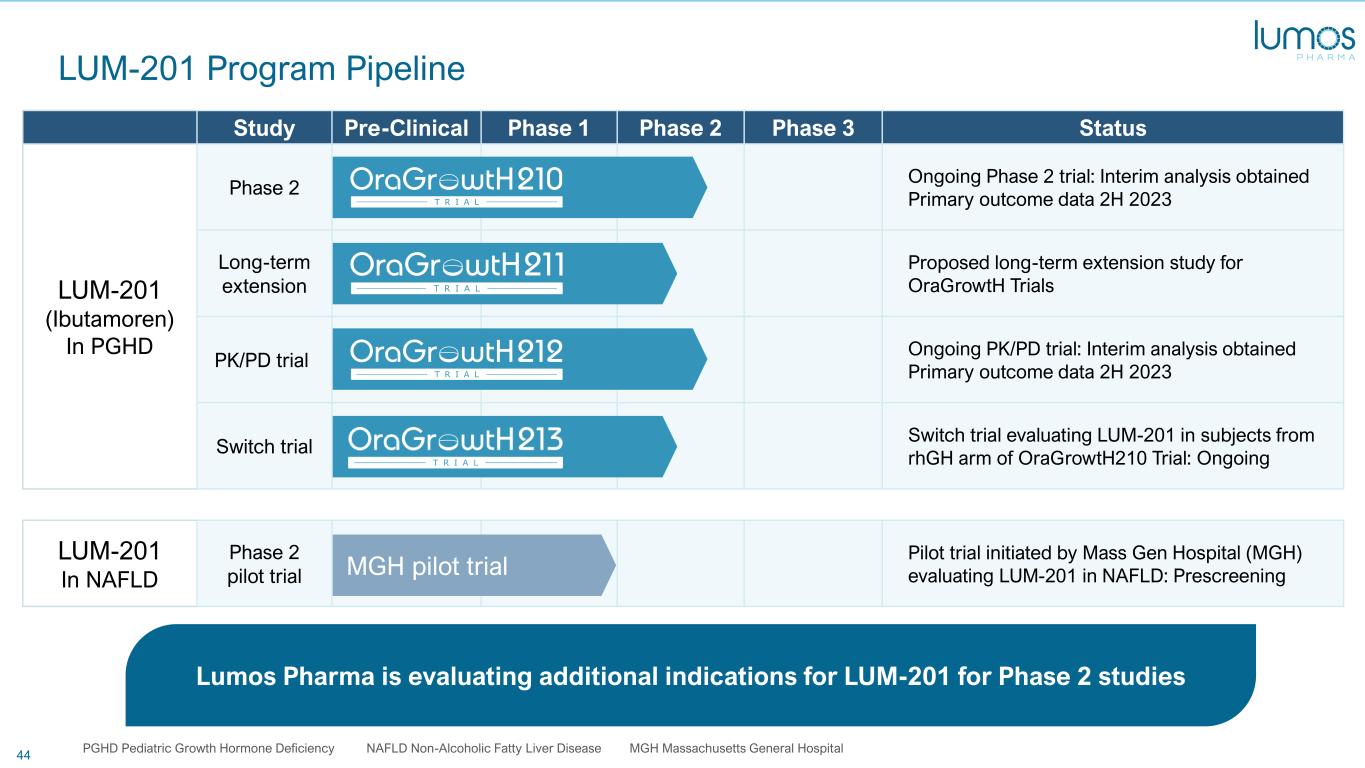
44 LUM-201 Program Pipeline Study Pre-Clinical Phase 1 Phase 2 Phase 3 Status LUM-201 (Ibutamoren) In PGHD Phase 2 Ongoing Phase 2 trial: Interim analysis obtained Primary outcome data 2H 2023 Long-term extension Proposed long-term extension study for OraGrowtH Trials PK/PD trial Ongoing PK/PD trial: Interim analysis obtained Primary outcome data 2H 2023 Switch trial Switch trial evaluating LUM-201 in subjects from rhGH arm of OraGrowtH210 Trial: Ongoing LUM-201 In NAFLD Phase 2 pilot trial Pilot trial initiated by Mass Gen Hospital (MGH) evaluating LUM-201 in NAFLD: Prescreening Lumos Pharma is evaluating additional indications for LUM-201 for Phase 2 studies PGHD Pediatric Growth Hormone Deficiency NAFLD Non-Alcoholic Fatty Liver Disease MGH Massachusetts General Hospital MGH pilot trial
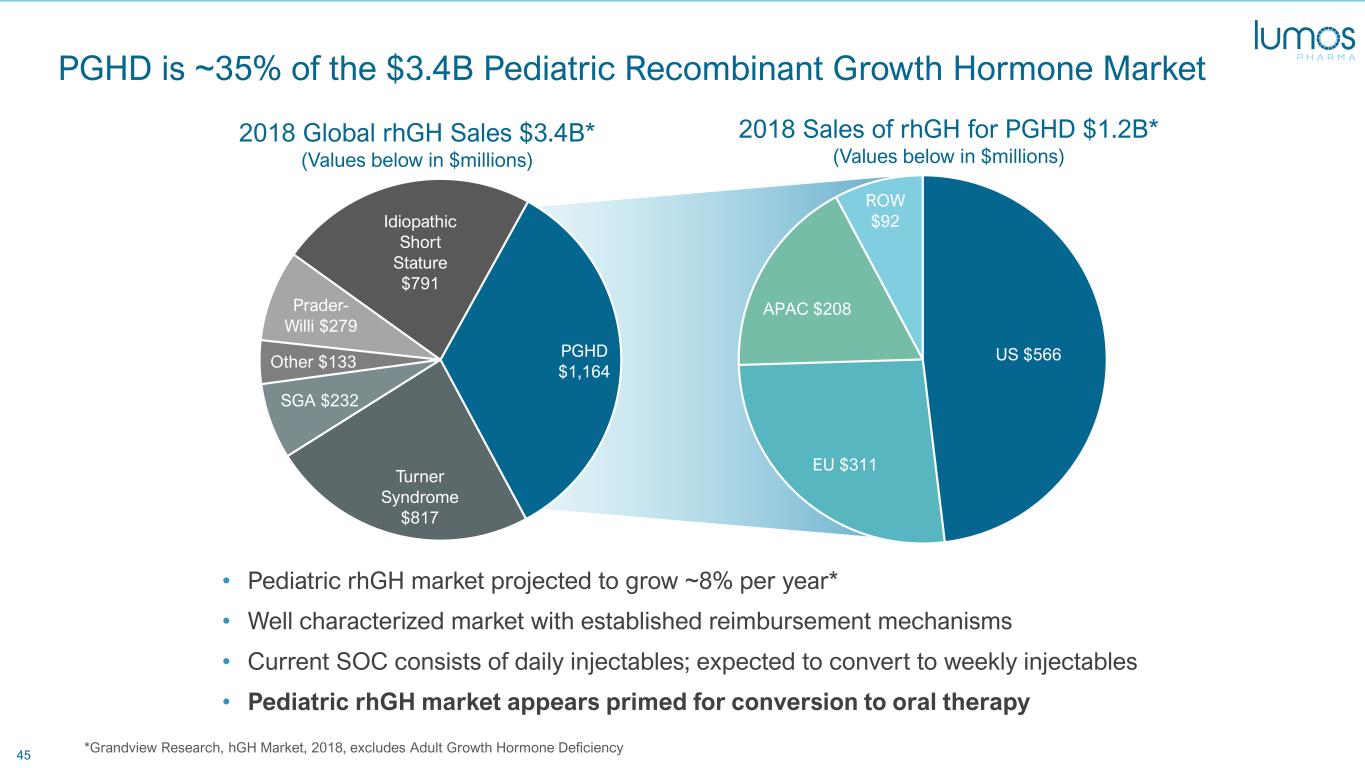
45 PGHD is ~35% of the $3.4B Pediatric Recombinant Growth Hormone Market • Pediatric rhGH market projected to grow ~8% per year* • Well characterized market with established reimbursement mechanisms • Current SOC consists of daily injectables; expected to convert to weekly injectables • Pediatric rhGH market appears primed for conversion to oral therapy *Grandview Research, hGH Market, 2018, excludes Adult Growth Hormone Deficiency PGHD $1,164 Turner Syndrome $817 SGA $232 Other $133 Prader- Willi $279 Idiopathic Short Stature $791 US $566 EU $311 APAC $208 ROW $92 2018 Global rhGH Sales $3.4B* (Values below in $millions) 2018 Sales of rhGH for PGHD $1.2B* (Values below in $millions)
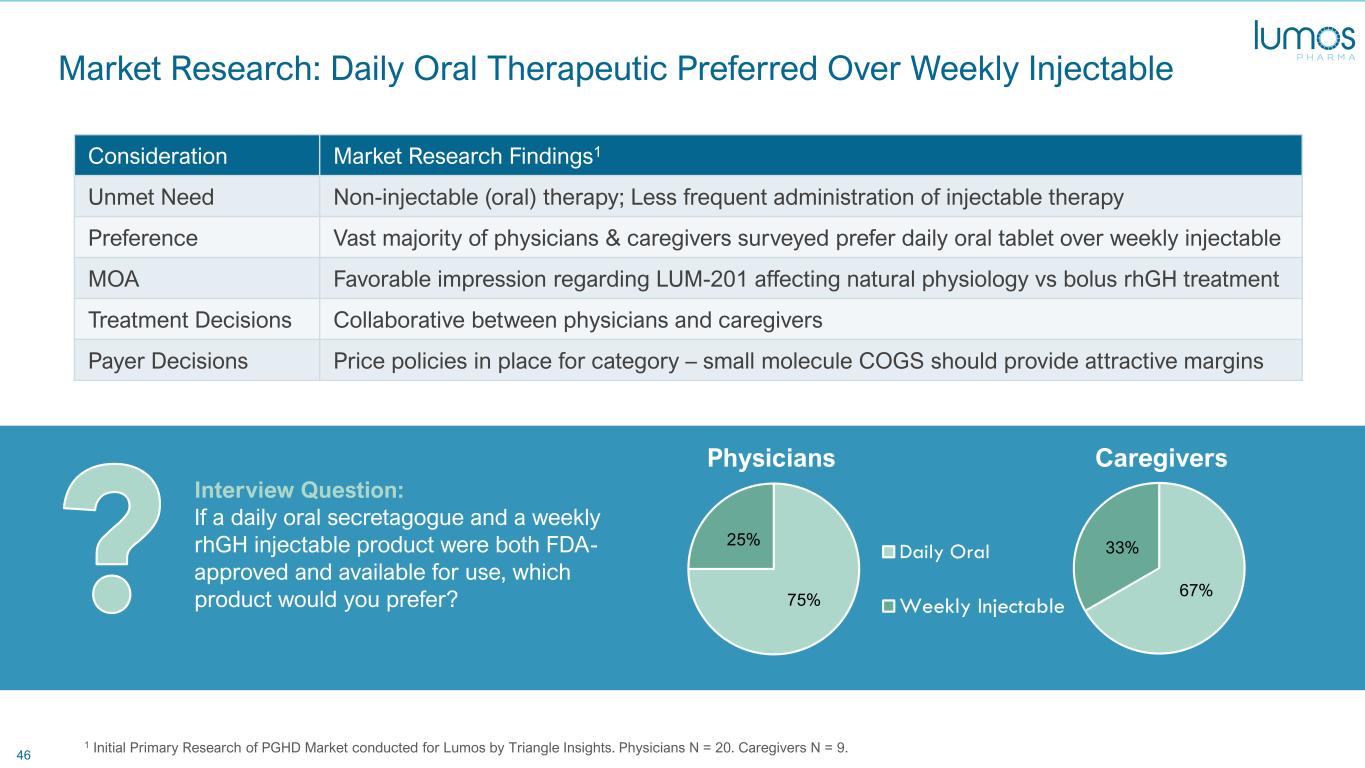
46 Market Research: Daily Oral Therapeutic Preferred Over Weekly Injectable 1 Initial Primary Research of PGHD Market conducted for Lumos by Triangle Insights. Physicians N = 20. Caregivers N = 9. 75% 25% Interview Question: If a daily oral secretagogue and a weekly rhGH injectable product were both FDA- approved and available for use, which product would you prefer? 67% 33%Daily Oral Weekly Injectable Physicians Caregivers Consideration Market Research Findings1 Unmet Need Non-injectable (oral) therapy; Less frequent administration of injectable therapy Preference Vast majority of physicians & caregivers surveyed prefer daily oral tablet over weekly injectable MOA Favorable impression regarding LUM-201 affecting natural physiology vs bolus rhGH treatment Treatment Decisions Collaborative between physicians and caregivers Payer Decisions Price policies in place for category – small molecule COGS should provide attractive margins
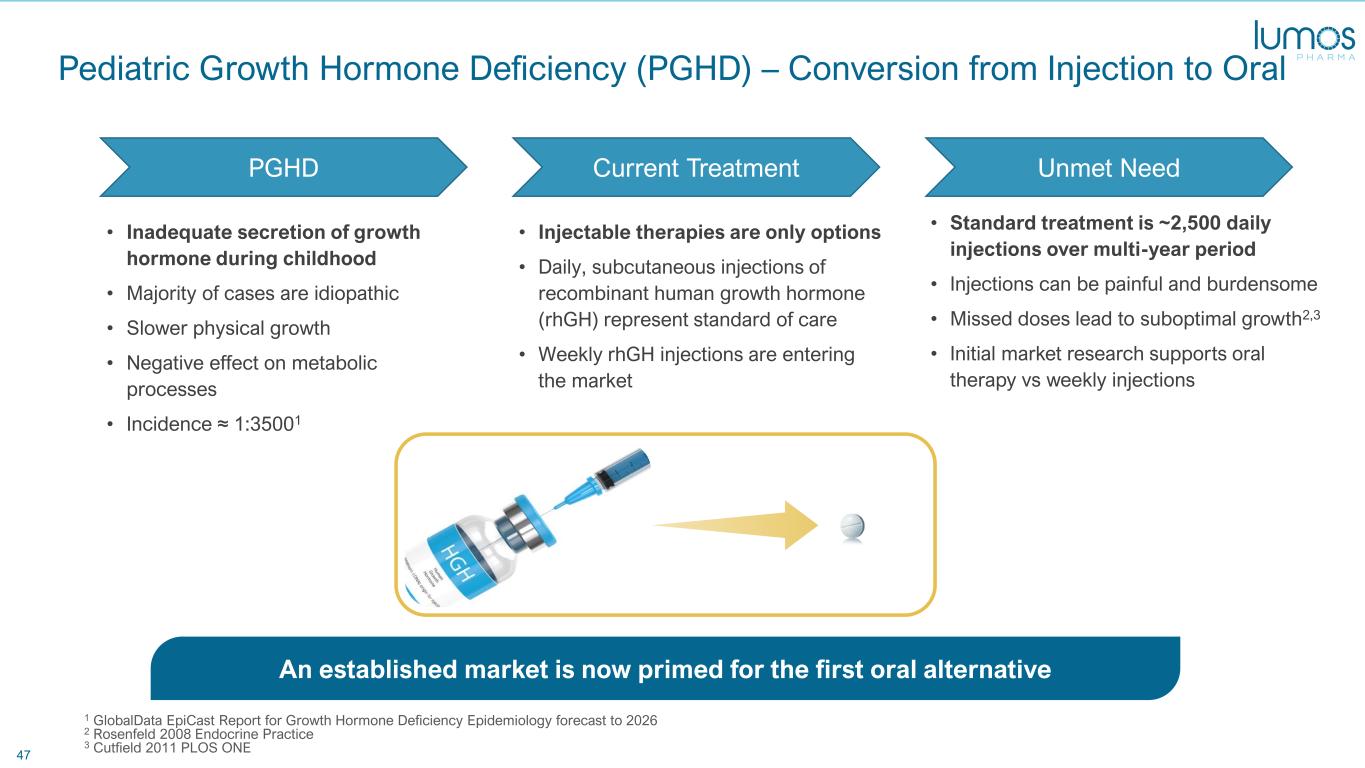
47 Pediatric Growth Hormone Deficiency (PGHD) – Conversion from Injection to Oral 1 GlobalData EpiCast Report for Growth Hormone Deficiency Epidemiology forecast to 2026 2 Rosenfeld 2008 Endocrine Practice 3 Cutfield 2011 PLOS ONE • Inadequate secretion of growth hormone during childhood • Majority of cases are idiopathic • Slower physical growth • Negative effect on metabolic processes • Incidence ≈ 1:35001 • Injectable therapies are only options • Daily, subcutaneous injections of recombinant human growth hormone (rhGH) represent standard of care • Weekly rhGH injections are entering the market • Standard treatment is ~2,500 daily injections over multi-year period • Injections can be painful and burdensome • Missed doses lead to suboptimal growth2,3 • Initial market research supports oral therapy vs weekly injections PGHD Current Treatment Unmet Need An established market is now primed for the first oral alternative
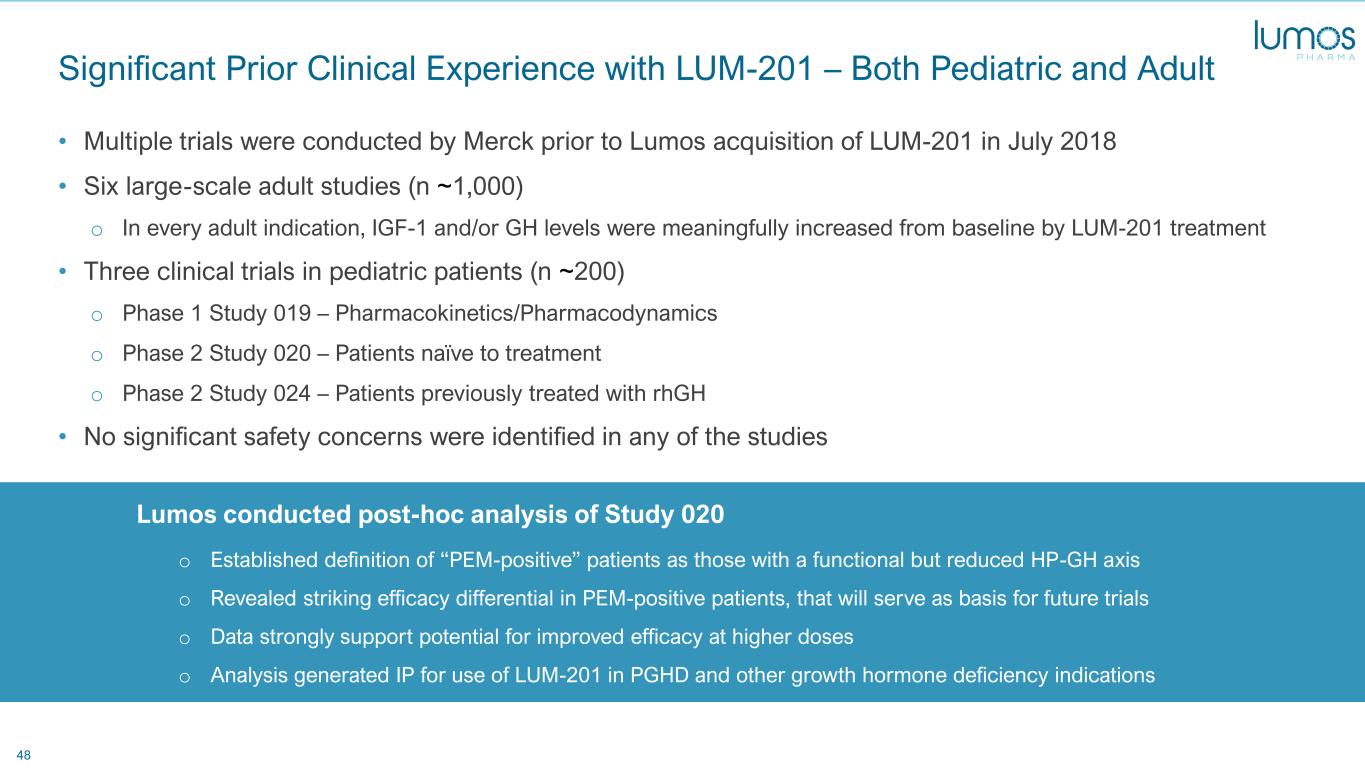
48 Significant Prior Clinical Experience with LUM-201 – Both Pediatric and Adult • Multiple trials were conducted by Merck prior to Lumos acquisition of LUM-201 in July 2018 • Six large-scale adult studies (n ~1,000) o In every adult indication, IGF-1 and/or GH levels were meaningfully increased from baseline by LUM-201 treatment • Three clinical trials in pediatric patients (n ~200) o Phase 1 Study 019 – Pharmacokinetics/Pharmacodynamics o Phase 2 Study 020 – Patients naïve to treatment o Phase 2 Study 024 – Patients previously treated with rhGH • No significant safety concerns were identified in any of the studies Lumos conducted post-hoc analysis of Study 020 o Established definition of “PEM-positive” patients as those with a functional but reduced HP-GH axis o Revealed striking efficacy differential in PEM-positive patients, that will serve as basis for future trials o Data strongly support potential for improved efficacy at higher doses o Analysis generated IP for use of LUM-201 in PGHD and other growth hormone deficiency indications
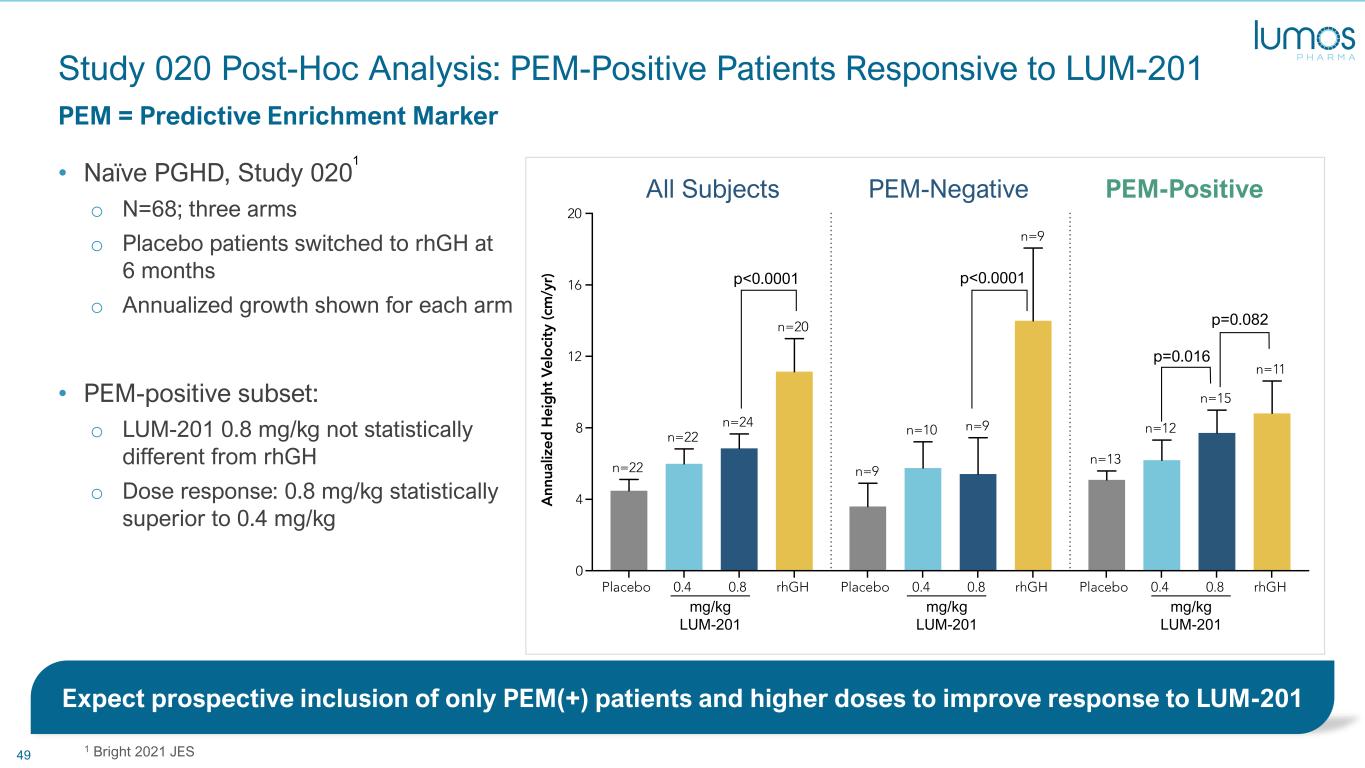
49 Study 020 Post-Hoc Analysis: PEM-Positive Patients Responsive to LUM-201 • Naïve PGHD, Study 020 o N=68; three arms o Placebo patients switched to rhGH at 6 months o Annualized growth shown for each arm • PEM-positive subset: o LUM-201 0.8 mg/kg not statistically different from rhGH o Dose response: 0.8 mg/kg statistically superior to 0.4 mg/kg PEM = Predictive Enrichment Marker 1 Bright 2021 JES All Subjects PEM-Negative PEM-Positive mg/kg LUM-201 mg/kg LUM-201 mg/kg LUM-201 p<0.0001 p<0.0001 p=0.082 p=0.016 Expect prospective inclusion of only PEM(+) patients and higher doses to improve response to LUM-201 1
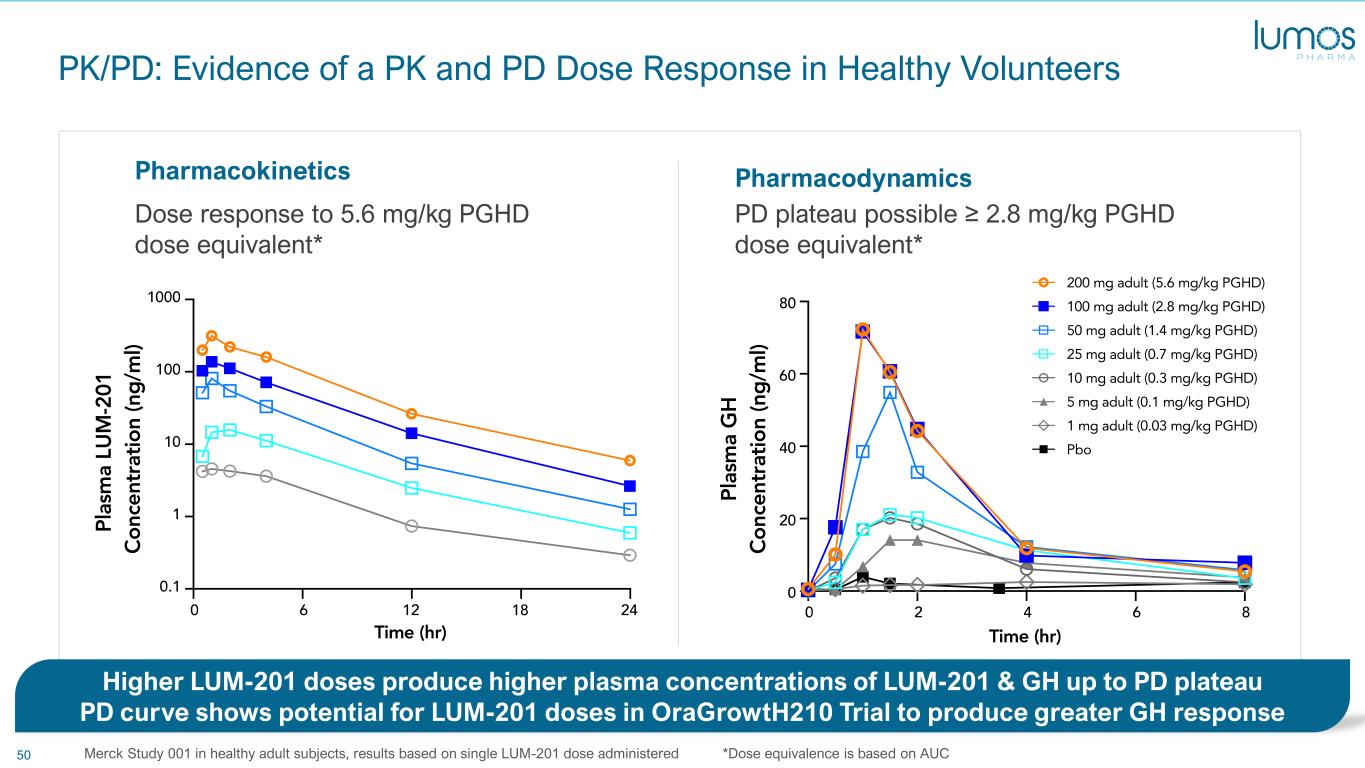
50 PK/PD: Evidence of a PK and PD Dose Response in Healthy Volunteers PharmacodynamicsPharmacokinetics Dose response to 5.6 mg/kg PGHD dose equivalent* PD plateau possible ≥ 2.8 mg/kg PGHD dose equivalent* Higher LUM-201 doses produce higher plasma concentrations of LUM-201 & GH up to PD plateau PD curve shows potential for LUM-201 doses in OraGrowtH210 Trial to produce greater GH response Merck Study 001 in healthy adult subjects, results based on single LUM-201 dose administered *Dose equivalence is based on AUC
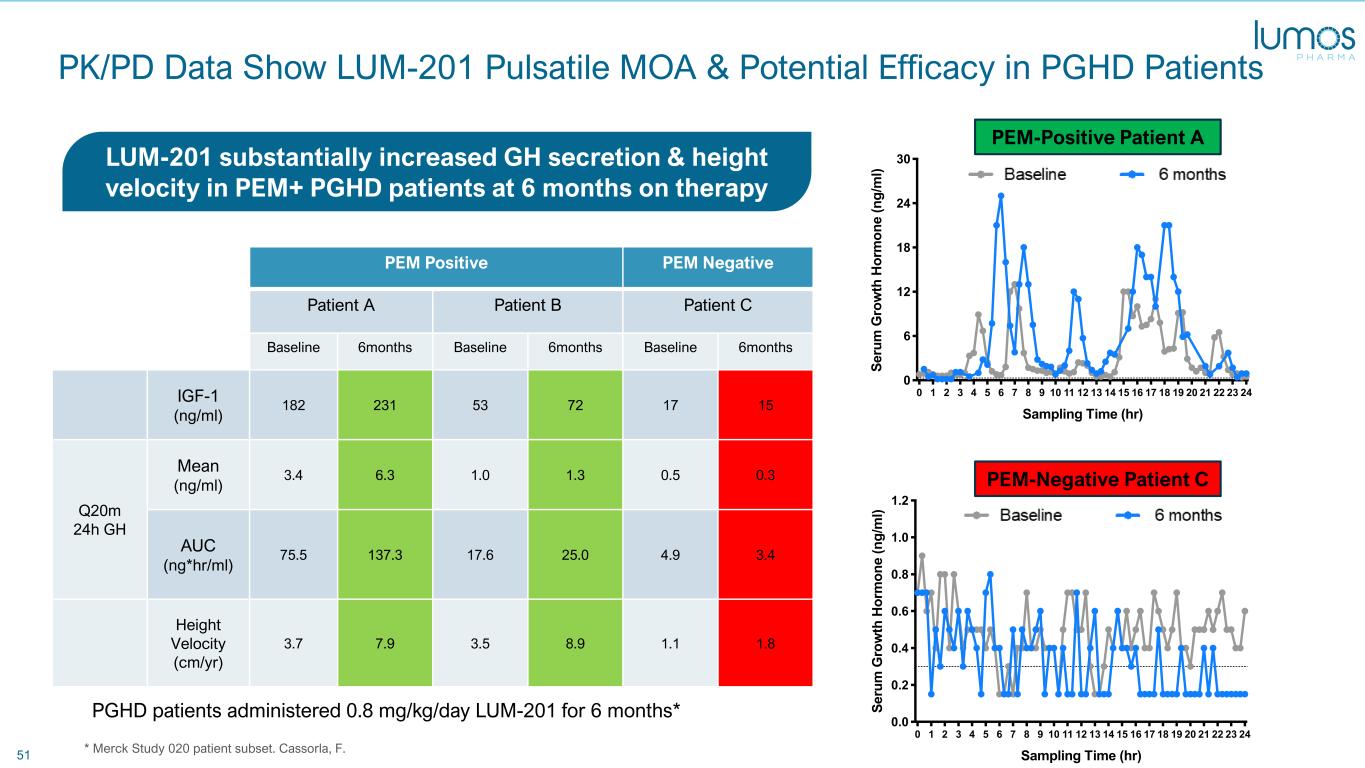
51 PK/PD Data Show LUM-201 Pulsatile MOA & Potential Efficacy in PGHD Patients * Merck Study 020 patient subset. Cassorla, F. PEM Positive PEM Negative Patient A Patient B Patient C Baseline 6months Baseline 6months Baseline 6months IGF-1 (ng/ml) 182 231 53 72 17 15 Q20m 24h GH Mean (ng/ml) 3.4 6.3 1.0 1.3 0.5 0.3 AUC (ng*hr/ml) 75.5 137.3 17.6 25.0 4.9 3.4 Height Velocity (cm/yr) 3.7 7.9 3.5 8.9 1.1 1.8 0 1 2 3 4 5 6 7 8 9 10 11 12 13 14 15 16 17 18 19 20 21 22 23 24 0 6 12 18 24 30 Sampling Time (hr) S e ru m G ro w th H o rm o n e ( n g /m l) Patient A Baseline 6 months 0 1 2 3 4 5 6 7 8 9 10 11 12 13 14 15 16 17 18 19 20 21 22 23 24 0.0 0.2 0.4 0.6 0.8 1.0 1.2 Sampling Time (hr) S e ru m G ro w th H o rm o n e ( n g /m l) Patient C Baseline 6 months PEM-Positive Patient A PEM-Negative Patient C PGHD patients administered 0.8 mg/kg/day LUM-201 for 6 months* LUM-201 substantially increased GH secretion & height velocity in PEM+ PGHD patients at 6 months on therapy
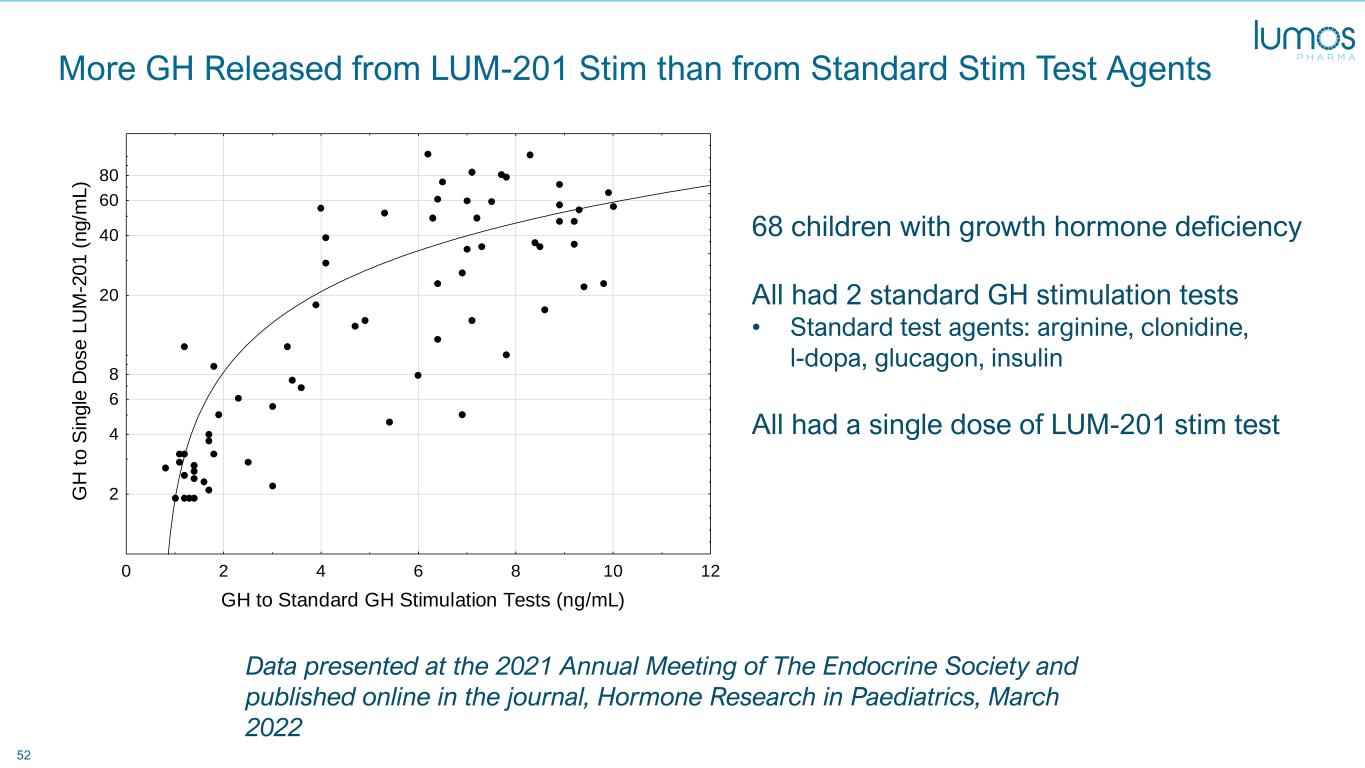
52 More GH Released from LUM-201 Stim than from Standard Stim Test Agents 0 2 4 6 8 10 12 GH to Standard GH Stimulation Tests (ng/mL) 2 4 6 8 20 40 60 80 G H t o S in g le D o s e L U M -2 0 1 ( n g /m L ) 68 children with growth hormone deficiency All had 2 standard GH stimulation tests • Standard test agents: arginine, clonidine, l-dopa, glucagon, insulin All had a single dose of LUM-201 stim test Data presented at the 2021 Annual Meeting of The Endocrine Society and published online in the journal, Hormone Research in Paediatrics, March 2022
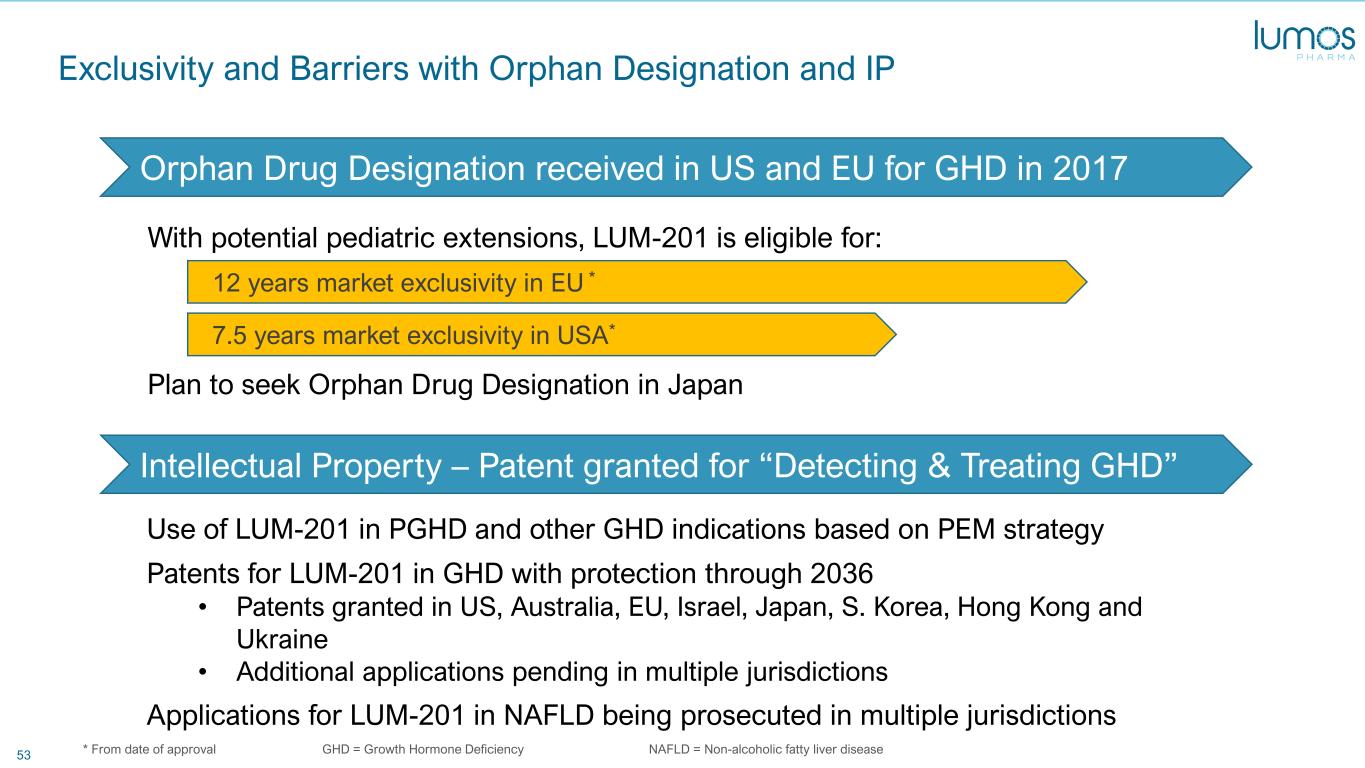
53 Exclusivity and Barriers with Orphan Designation and IP With potential pediatric extensions, LUM-201 is eligible for: Plan to seek Orphan Drug Designation in Japan Use of LUM-201 in PGHD and other GHD indications based on PEM strategy Patents for LUM-201 in GHD with protection through 2036 • Patents granted in US, Australia, EU, Israel, Japan, S. Korea, Hong Kong and Ukraine • Additional applications pending in multiple jurisdictions Applications for LUM-201 in NAFLD being prosecuted in multiple jurisdictions Orphan Drug Designation received in US and EU for GHD in 2017 Intellectual Property – Patent granted for “Detecting & Treating GHD” 12 years market exclusivity in EU * 7.5 years market exclusivity in USA* * From date of approval GHD = Growth Hormone Deficiency NAFLD = Non-alcoholic fatty liver disease
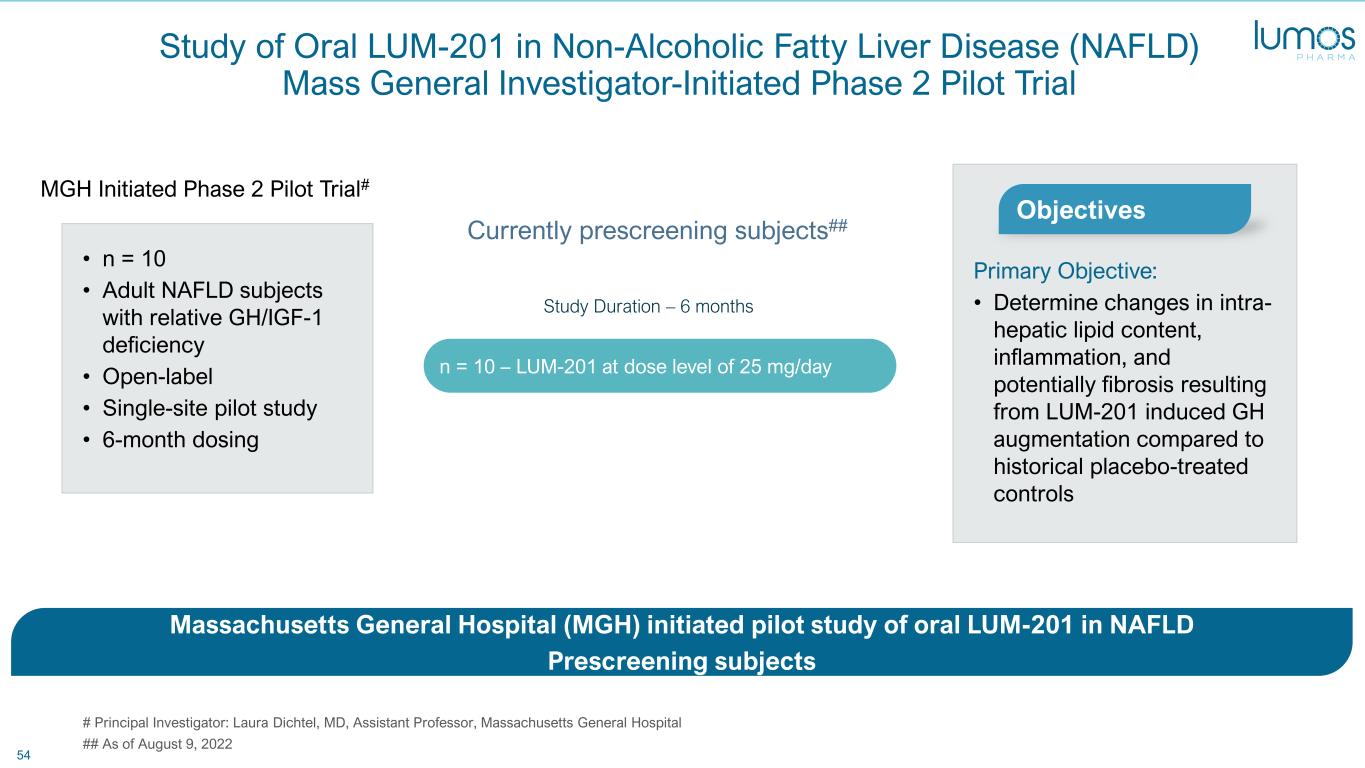
54 • n = 10 • Adult NAFLD subjects with relative GH/IGF-1 deficiency • Open-label • Single-site pilot study • 6-month dosing Study of Oral LUM-201 in Non-Alcoholic Fatty Liver Disease (NAFLD) Mass General Investigator-Initiated Phase 2 Pilot Trial Primary Objective: • Determine changes in intra- hepatic lipid content, inflammation, and potentially fibrosis resulting from LUM-201 induced GH augmentation compared to historical placebo-treated controls Massachusetts General Hospital (MGH) initiated pilot study of oral LUM-201 in NAFLD Prescreening subjects Objectives n = 10 – LUM-201 at dose level of 25 mg/day Study Duration – 6 months MGH Initiated Phase 2 Pilot Trial# Currently prescreening subjects## # Principal Investigator: Laura Dichtel, MD, Assistant Professor, Massachusetts General Hospital ## As of August 9, 2022
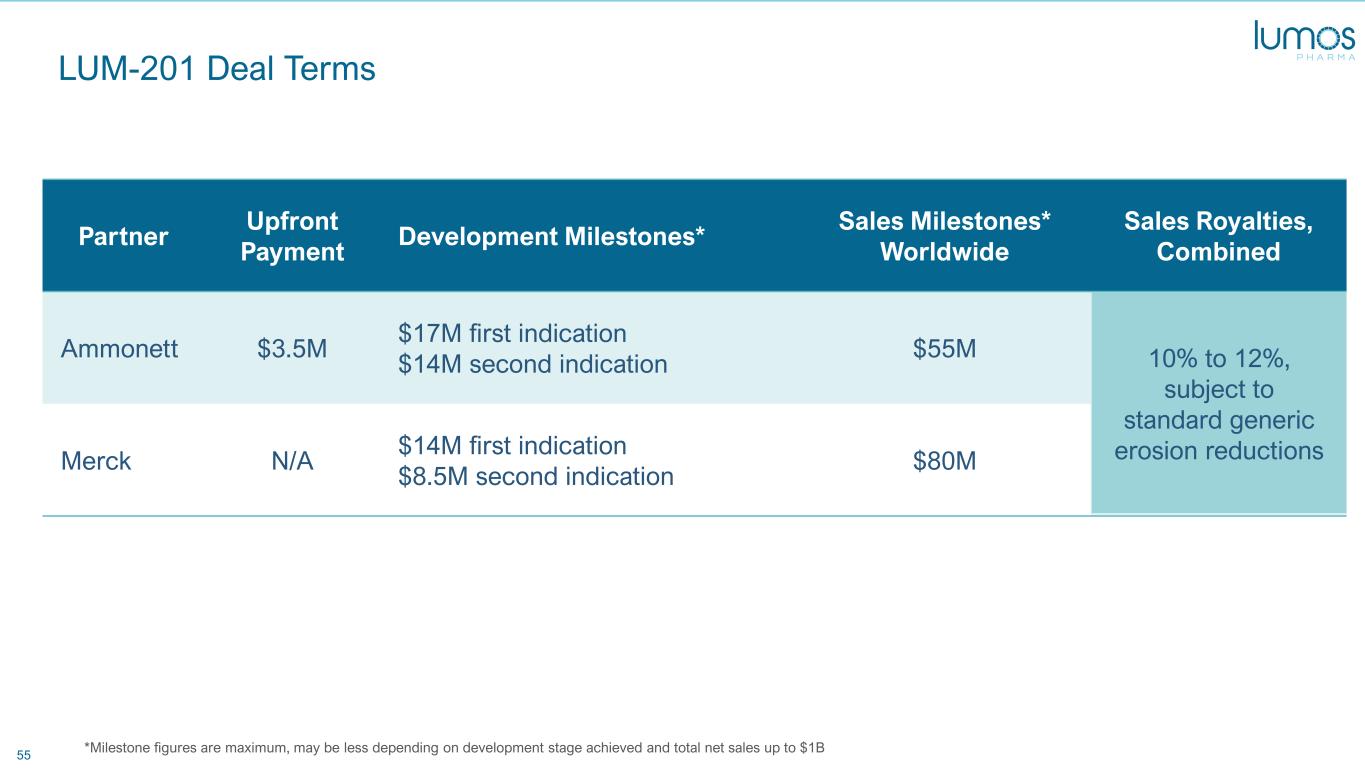
55 LUM-201 Deal Terms *Milestone figures are maximum, may be less depending on development stage achieved and total net sales up to $1B Partner Upfront Payment Development Milestones* Sales Milestones* Worldwide Sales Royalties, Combined Ammonett $3.5M $17M first indication $14M second indication $55M Merck N/A $14M first indication $8.5M second indication $80M 10% to 12%, subject to standard generic erosion reductions






















































